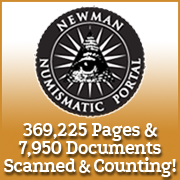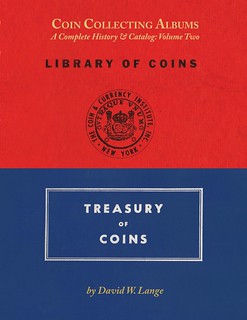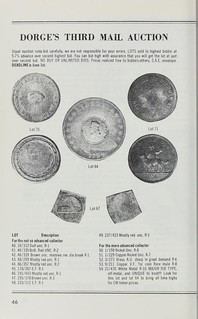
About UsThe Numismatic Bibliomania Society is a non-profit organization devoted to the study and enjoyment of numismatic literature. For more information please see our web site at coinbooks.org SubscriptionsThose wishing to become new E-Sylum subscribers (or wishing to Unsubscribe) can go to the following web page link MembershipThere is a membership application available on the web site Membership Application To join, print the application and return it with your check to the address printed on the application. Print/Digital membership is $40 to addresses in the U.S., and $75 elsewhere. A digital-only membership is available for $25. For those without web access, write to: Terry White, Treasurer
AsylumFor Asylum mailing address changes and other membership questions, contact Terry at this email address: terrywhite5475@yahoo.com SubmissionsTo submit items for publication in The E-Sylum, just Reply to this message, or write to the Editor at this address: whomren@gmail.com BUY THE BOOK BEFORE THE COINSale Calendar |
- WAYNE'S WORDS: THE E-SYLUM SEPTEMBER 4, 2016
- ASYLUM AUTUMN 2016 ISSUE PUBLISHED
- NEW BOOK: FUGIO COPPER NOTES
- NEW BOOK: GUIDE BOOK OF MORGAN SILVER DOLLARS, 5TH EDITION
- NEW BOOK: A GUIDE BOOK OF PEACE DOLLARS, 3RD EDITION
- NEW BOOK: WEALTH AND WARFARE
- DOUBLE DIMES BOOK ADDENDA AVAILABLE
- BOOK REVIEW: COIN COLLECTING ALBUMS VOLUME 2
- BOOK REVIEW: THE BOOK
- VANHOUDT WINS 2016 PNG FRIEDBERG AWARD
- NEWMAN PORTAL DIGITIZES APFELBAUM RARE COIN COURSE
- PRICED AND NAMED EDWARD MARIS CATALOG SOUGHT
- MORE ON SAXTON'S 1839 PHOTO FROM THE U.S. MINT
- U.S. MINT PLANS COIN FORUM OCTOBER 13, 2016
- NOTES FROM E-SYLUM READERS: SEPTEMBER 4, 2016
- ONLY QUARTERS AND HALF EAGLES COINED IN 1815
- THE 40-YEAR JOURNEY OF TWO HALF DOLLARS
- LUTHER C. BRYANT (1801-1886)
- THE TWO DOLLAR BILL DOCUMENTARY
- CERTIFYING THE D.B. COOPER RANSOM BANKNOTES
- 2016 TOKEN CONGRESS OCTOBER 7-9, 2016
- MCA ADVISORY JULY/AUGUST 2016 ISSUE PUBLISHED
- CLASSICAL NUMISMATIC GROUP SALE 103
- AN INVESTIGATION OF ISIS COINAGE (ENGLISH SYNOPSES)
- MORE ON THE BENJAMIN FRANKLIN COUNTERSTAMP
- A NUMISMATIC CONNECTION TO MOE BERG
- AZERBAIJAN HOARD OF MEDIEVAL ISLAMIC COINS
- SELECTIONS FROM TIMOTHY MILLETT LIMITED
- RUSSIAN COPPER COINAGE AND THE SOHO MINT
- MORE ON BARMAID'S GRIEF
- JOHN NASH’S NOBEL MEDAL TO BE AUCTIONED
- RARE GOLD LIFEBOAT DISASTER MEDAL MISSING
- BOND PRICES AND EARLY AMERICAN FINANCE
- SHELL OIL'S PRESIDENT'S GAMEPIECE PACKAGING
- AUSTRALIA LAUNCHES TACTILE BANKNOTE
- RIOS LAUNCHES TEACHERS RIGHTING HISTORY
- CHINESE CAPTIVE SAVED BY MESSAGES ON BANKNOTES
- FEATURED WEB PAGE: 125 YEARS OF COLLECTING
Click here to access the complete archive
To comment or submit articles, reply to whomren@gmail.com
WAYNE'S WORDS: THE E-SYLUM SEPTEMBER 4, 2016
New subscribers this week include: Mike McDaniel, courtesy of Dave Perkins, Prof. Shaul Ladany, courtesy of Bill Rosenblum, and Lee Barrett. Welcome aboard! We now have 2,009 subscribers.
Guess what today is, folks! It's the anniversary of The E-Sylum, which debuted on September 4, 1998. See our searchable
online archive for all back issues.
www.coinbooks.org/club_nbs_esylum_archive.html
You can also access the complete table of contents here. We've published nearly 19 volumes: 946 issues containing 21,391 articles in
all.
www.coinbooks.org/esylum_toc.html
This week we open with a great new issue of our print journal The Asylum, four new books and two reviews. Other topics this week include the Institute of Numismatic and Philatelic Studies at Adelphi University, the Maris sale, the U.S. coinage of 1815, the two dollar bill. ISIS coinage, and Australia's new tactile banknote.
To learn more about Fugio coppers, the 1964 Morgan dollar, cockled parchment, dealer Luther Bryant, the Cursing Half Noble, Bobby the Welshman, George the Rat, the Erection of Wilton Church and what galoshes had to do with it, read on. Have a great week, everyone!
Wayne Homren
Editor, The E-Sylum
ASYLUM AUTUMN 2016 ISSUE PUBLISHED
The Asylum Special Issue: The Future of Numismatic Literature
By Maria Fanning, Editor
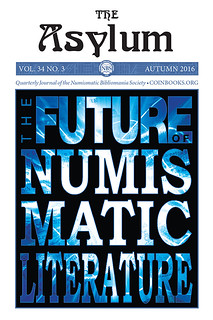 Since entering the world of numismatic literature I have heard various opinions on what its future might be—some very optimistic and others
wary of the direction it seems to be headed. Since becoming the editor of The Asylum I have had more discussions with passionate NBS members
and have asked several from various aspects of the field to share their thoughts on the future of numismatic literature for this special issue. I
have attempted to include as many viewpoints as possible, asking collectors, researchers, librarians, authors and booksellers to share their opinions
on where numismatic books fit into our changing world.
Since entering the world of numismatic literature I have heard various opinions on what its future might be—some very optimistic and others
wary of the direction it seems to be headed. Since becoming the editor of The Asylum I have had more discussions with passionate NBS members
and have asked several from various aspects of the field to share their thoughts on the future of numismatic literature for this special issue. I
have attempted to include as many viewpoints as possible, asking collectors, researchers, librarians, authors and booksellers to share their opinions
on where numismatic books fit into our changing world.
While digital media is growing at an ever-expanding rate, the value of artisan, hand-crafted and vintage objects also increases. Where does that leave collectors and students of history like us? Does the digital world eclipse artifacts from our past or does it help to enhance our understanding of history? Will open access to obscure information increase interest in numismatic books and catalogues or render them worthless?
The struggle is evident in the greater world as well, as laws defining copyright and piracy are debated and artists and podcasters create careers by giving their work away for free. Students have more access to information than ever through use of the internet in their classrooms while teachers place historical artifacts and original source material in their students’ hands to forge a connection with the past.
My hope is that this issue will be a starting point for fine-tuning our approach to the new global environment and encouraging more open discussion of the advantages and dangers of the use of new technologies in collecting and researching. Of one thing I am certain—everyone who has an opinion about the future of numismatic literature cares very deeply about sustaining it and has made the preservation of history a priority in their hearts.
The Asylum Table of Contents
Special Issue: The Future of Numismatic Literature
Autumn 2016
NBS Symposium and Annual Meeting Report by Joel J. Orosz
Printed or Electronic Books: Each Holds Advantages for Research by David Hill
Lawrenceville or Louisville? by Joel J. Orosz
Future Boy Modernizes Numismatics by Wayne Homren
Thoughts on Writing a Print Media Book in a Digital World by Neil Musante
A Dying Profession? by Charles Davis
Slicing the Bibliophilic Landscape by Len Augsberger
The Economics of Numismatic Literature and Research by David F. Fanning
A Positive Future for Numismatic Literature by Elizabeth Hahn Benge
Aspects of Numismatic Literature Digitization by Dan Hamelberg
History in Your Hands Foundation: A new approach to teaching history by Shanna Berk Schmidt
My hardcopy arrived in the mail yesterday. It looks great! The picture Maria found for my article is priceless! I read a couple articles, but most of my spare time on weekends is devoted to The E-Sylum. I'll finish it Monday. -Editor
To join NBS or renew your annual membership, see:
www.coinbooks.org/about/membership.html
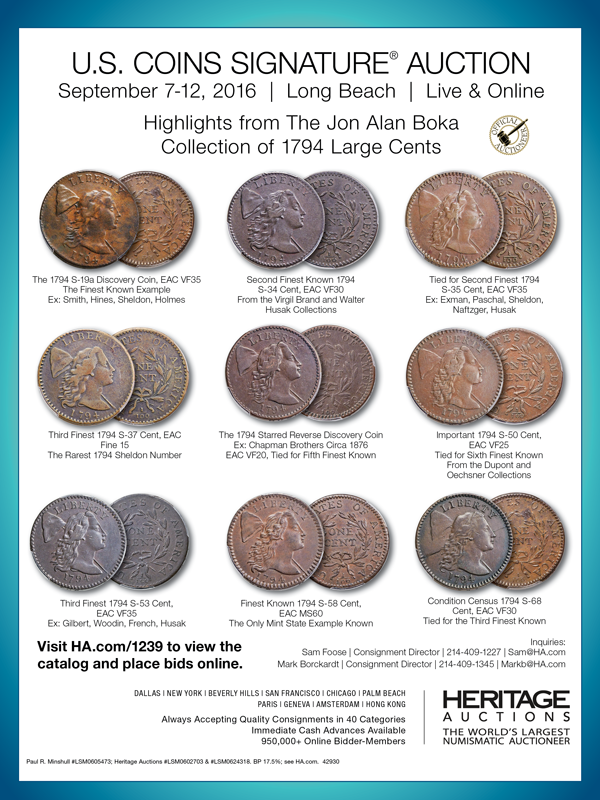
NEW BOOK: FUGIO COPPER NOTES
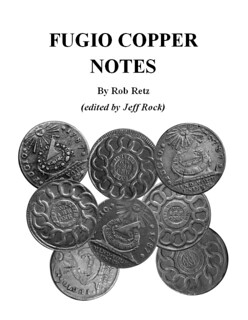 Many colonial collectors remember Rob Retz and know that when he passed away in 2004 he left behind a book on the 1787 Fugio coppers, which
he had worked on for several years, gaining access to some of the largest collections of the series then formed. The book was nearly ready for
publication at that time, but Rob’s final months were – understandably! – spent with his family and friends, and numismatics was not as pressing as
it had been before. The non-publication of this book was a loss to the colonial hobby, even though a few years later the new edition of Eric Newman’s
work on the Fugio coppers did see print.
Many colonial collectors remember Rob Retz and know that when he passed away in 2004 he left behind a book on the 1787 Fugio coppers, which
he had worked on for several years, gaining access to some of the largest collections of the series then formed. The book was nearly ready for
publication at that time, but Rob’s final months were – understandably! – spent with his family and friends, and numismatics was not as pressing as
it had been before. The non-publication of this book was a loss to the colonial hobby, even though a few years later the new edition of Eric Newman’s
work on the Fugio coppers did see print.
In helping to edit the Newman book, John Kraljevich made the decision not to use any of the material Rob had put together for his own book, in the hope that Rob’s work would soon be published. Unfortunately that was not the case, and the book remained dormant for a decade.
It is with great pleasure though that we announce that Rob’s book has finally been published. Through the generosity of Syd Martin and Tony Terranova, who underwrote the printing costs, this work is now available to collectors. This 162-page book gives detailed information on every variety of Fugio copper, along with high quality photographs, a detailed introduction by the editor, die state information, attribution tips and an appendix examining the Dr. Hall collection of Fugio coppers. The heart of Rob’s book though is the Condition Census information he compiled, with examples graded by him and named to the collections in which they were then held; all this information was state of the art at the time, not available anywhere else, and it was felt that it would be useful to collectors to have it in print.
While the book itself is a testimonial to Rob Retz, it is more than a museum piece – it should be quite useful to today’s collector, and blends perfectly with the Newman book. With these two references and a handful of major auction catalogues the collector will have everything he needs to pursue this series.
The book itself has been a labor of love, something of a rarity in numismatics. Extensively edited pro bono by Jeff Rock, with all-new photographs contributed through the kindness of Stack’s-Bowers and a handful of collectors and distributed for free by Charlie Davis, ALL sales proceeds – not just the profits, but every penny! – go to the Rob Retz Memorial Fund set up with C4 to further work with Young Numismatists, the very future of our hobby, and a cause near to Rob’s heart.
The book is being released in a limited edition of just 90 perfect-bound, soft-covered copies. There are 10 special edition hardcover copies that are reserved for presentation purposes, for a total press run of just 100 books. But if you are a diehard bibiliomaniac and want one of the hardcover volumes, one will be offered in this year’s C4 auction as a donated lot – ALL proceeds will again go to the club (and as it is a nonprofit there are probably tax advantages to bidding strong!).
If the demand is greater than expected a second printing (noted as such) might be run, but there will only be the 10 hardcover editions printed, each of which is signed by the editor, Rob’s wife Margaret and their two daughters Angela and Nicole.
The regular soft cover editions will be available at the 2016 C4 Convention in Baltimore at the table of Charlie Davis. They are priced at $45 if you pick them up at the show, or $50 mailed to you. Charlie, who also knew Rob as a friend, is distributing the book free of charge and can be reached by email at: numislit@aol.com.

NEW BOOK: GUIDE BOOK OF MORGAN SILVER DOLLARS, 5TH EDITION
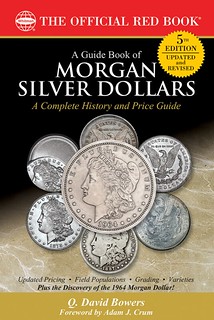 Whitman Publishing announces the release of the new fifth edition of A Guide Book of Morgan Silver Dollars, by Q. David Bowers. The
304-page book will be available from booksellers and hobby shops nationwide on September 27, 2016, for $19.95. Before then it is available for
preorder (including online at www.Whitman.com).
Whitman Publishing announces the release of the new fifth edition of A Guide Book of Morgan Silver Dollars, by Q. David Bowers. The
304-page book will be available from booksellers and hobby shops nationwide on September 27, 2016, for $19.95. Before then it is available for
preorder (including online at www.Whitman.com).
The pricing, text, and certified population data in the fifth edition have been edited and updated. New research covers counterfeit error coins and other topics, including a numismatic bombshell: recent discoveries and photographs revealing the previously unknown 1964 Morgan silver dollar.
“The world of collecting Morgan dollars is full of the kind of historical intrigue that makes up any legend,” said professional numismatist Adam Crum in his foreword, “with roots reaching deep into the mines of the Comstock Lode and into the minds of numismatic scholars and collectors alike.”
The fifth edition includes a history of the silver dollar dating back to the 1790s, and chapters on the Morgan dollar’s design, its minting process, the five mints that struck the coin from 1878 to 1921, and Treasury hoards and other accumulations. Collectors benefit from advice on ways to collect Morgan dollars; grading and the marketplace; and how to specialize in die varieties. The book’s year-by-year catalog is an analysis by date and mintmark of more than 100 coins in the series, priced in up to eleven circulated grades and three levels of Proof. Appendices offer further study of Morgan dollar patterns and error and misstruck coins.
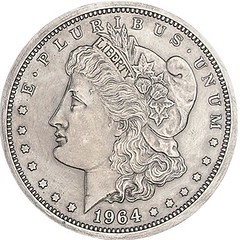 The Bowers Series is a popular Whitman Publishing library of numismatic books, each covering a different segment of the hobby. So far 23
volumes have been published, written by Bowers and other authors including David W. Lange, Rick Snow, Katherine Jaeger, Frank J. Colletti, Roger W.
Burdette, and Rick Tomaska. Together they comprise more than 6,000 pages of information.
The Bowers Series is a popular Whitman Publishing library of numismatic books, each covering a different segment of the hobby. So far 23
volumes have been published, written by Bowers and other authors including David W. Lange, Rick Snow, Katherine Jaeger, Frank J. Colletti, Roger W.
Burdette, and Rick Tomaska. Together they comprise more than 6,000 pages of information.
Because Whitman Publishing is the Official Supplier of the American Numismatic Association, ANA members receive 10% off the book when purchasing directly from the publisher. It can also be borrowed for free as a benefit of ANA membership, through the Dwight N. Manley Numismatic Library.
A Guide Book of Morgan Silver Dollars, fifth edition
By Q. David Bowers; foreword by Adam Crum
ISBN 0794844111 · 6 x 9 inches, softcover, 304 pages, full color · Retail $19.95 U.S.
For more information, or to order, see:
A Guide Book of
Morgan Silver Dollars, 5th Edition
(www.whitman.com/store/Inventory/Detail/A-Guide-Book-of-Morgan-Silver-Dollars-5th-Edition+0794844111)
Congratulations to John, Dennis and the whole research team, and thanks to the U.S. Mint personnel who granted them access. This story is still being written! -Editor
To read the earlier E-Sylum article, see:
Details on
the 1964 Morgan dollar: Here’s what we know
(www.coinworld.com/news/us-coins/2016/08/new-details-on-the-1964-morgan-dollar-and-the-1964-peace-dollar.html)
Dennis adds:
To say that the atmosphere was electric is an understatement. You can imagine our excitement at the discovery of the models --- and then to learn about the hubs and dies --- almost too amazing to believe!
I’m attaching a photo that was taken of us just moments after the discovery of the galvanos or models.
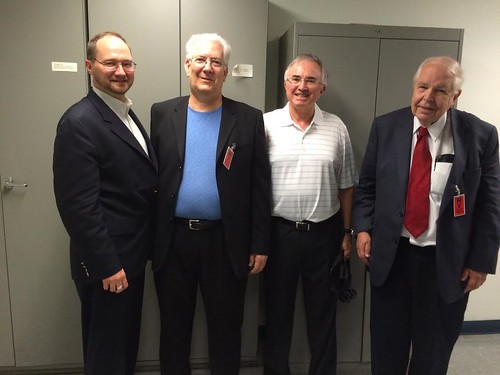
Dennis Tucker, John Dannreuther, David Sundman, and Q. David Bowers
NEW BOOK: A GUIDE BOOK OF PEACE DOLLARS, 3RD EDITION
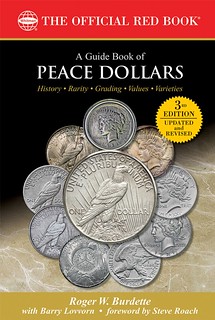 Whitman Publishing announces the release of the updated and revised third edition of the Guide Book of Peace Dollars, by
award-winning numismatic researcher Roger W. Burdette. The 288-page book will be available from booksellers and hobby shops nationwide on September
27, 2016, for $19.95. Before then it is available for preorder (including online at www.Whitman.com).
Whitman Publishing announces the release of the updated and revised third edition of the Guide Book of Peace Dollars, by
award-winning numismatic researcher Roger W. Burdette. The 288-page book will be available from booksellers and hobby shops nationwide on September
27, 2016, for $19.95. Before then it is available for preorder (including online at www.Whitman.com).
The Guide Book of Peace Dollars, a volume in Whitman’s popular “Bowers Series” of numismatic references, covers every date and mintmark, plus significant die varieties, of America’s last 90% silver dollar, struck from 1921 to 1935. The coin began as a commemorative of peace after the violent upheavals of World War I. Burdette studies Proofs, patterns, trial pieces, errors and misstrikes, countermarks, and famous collections. Noted Peace dollar collector Barry Lovvorn assisted with the coin-by-coin study and contributed other research.
“The Peace dollar is often unfairly overshadowed by its predecessor, the Morgan dollar,” wrote Coin World editor-at-large Steve Roach in the book’s foreword. “The sensitive Peace dollar offers a different, and perhaps a more accessible, collecting experience. The 1921 Peace dollar, with its high relief, is undoubtedly one of the most attractive 20th-century coins.”
Chapter 4 offers detailed analysis of the mysterious 1964-D Peace dollar, providing for the first time ever a photograph of an obverse die discovered in the Philadelphia Mint. “In order to learn as much as possible about the 1964-D Peace dollar, I extended my research beyond the usual musty archives,” Burdette said. “I interviewed all of the surviving Denver Mint employees who worked there during May 1965, when the back-dated 1964 Peace dollars were struck. Michael Lantz, a 34-year pressman, was particularly helpful in introducing me to former employees and providing background information. He was a die setter and press operator who retired in 1995 as production general foreman. These interviews opened interesting avenues about how the Denver Mint operated and its daily work.”
Burdette explores the origins and history of the Peace dollar (including the American Numismatic Association’s involvement), early designs and casts, and the coin’s production process. For hobbyists he lays out ways to collect and grade the coins, studies the market effect of hoards and meltings, and illustrates unusual examples. In addition to a coin-by-coin analysis that includes market values and rarity ratings, Burdette presents the biographies of key participants in the Peace dollar’s story, a Van Allen–Mallis cross-reference, a bibliography, and an index. To help clarify the Proof issues of 1921 and 1922, he has added a new table of pattern and experimental pieces and has updated information on the 1922 productions.
The first edition of the Guide Book of Peace Dollars debuted at 11 o'clock, November 11, 2008--the 90th anniversary of the official ceasefire that brought peace after the Great War. The second edition was released in June of 2012.
Author Roger W. Burdette is a former member of the Citizens Coinage Advisory Committee, which advises the Ssecretary of the Treasury on coinage and medals. He is the author of the three-part Renaissance of American Coinage, each volume of which won the Numismatic Literary Guild’s “Book of the Year” award, and From Mine to Mint, which was also a “Book of the Year” winner. He is a contributor to the Guide Book of United States Coins (the “Red Book”), and has shared insight in numerous other Whitman books. As an independent researcher his recent work has delved into World War II experimental and pattern pieces, 19th-century mint operations, U.S. proof coins from 1936 to 1942, and the annually convened U.S. Assay Commission.
Because Whitman Publishing is the Official Supplier of the American Numismatic Association, ANA members receive 10% off the book when purchasing directly from the publisher. It can also be borrowed for free as a benefit of ANA membership, through the Dwight N. Manley Numismatic Library.
A Guide Book of Peace Dollars, third edition
By Roger W. Burdette; foreword by Steve Roach ISBN 0794844138 · 6 x 9 inches, softcover, 288 pages, full color · Retail $19.95 U.S.
For more information, or to order, see:
A Guide Book of Peace
Dollars, 3rd Edition (www.whitman.com/store/Inventory/Detail/A-Guide-Book-of-Peace-Dollars-3rd-Edition+0794844138)
THE BOOK BAZARRE
NEW BOOK: WEALTH AND WARFARE
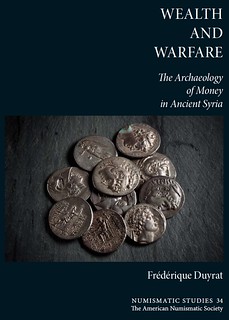 Wealth and Warfare: The Archaeology of Money in Ancient Syria
Wealth and Warfare: The Archaeology of Money in Ancient Syria
(Numismatic Studies 34)
by Frédérique Duyrat
List price: $200 plus shipping & handling
Member price: $140 plus shipping & handling
ISSN 0517-404-x
ISBN 978-0-89722-346-1
Hardcover, 550 text pages with tables, b/w figures
This book assembles for the first time the evidence for coin finds in the region of ancient Syria from the 5th to the 1st century BCE. A full catalogue of all known coin hoards and published excavation finds serves as the basis for an explanation of monetary behavior in an area extending over parts of modern Syria, Lebanon, Israel, Jordan, Palestine, and Turkey. In seven chapters of analysis, the author seeks to establish the limits of what we can learn from coin circulation, to compare the data from commerce to the data from legal excavations, to try to understand the chronological evolution of coin circulation and how much political events or warfare affect it, and to evaluate what coin finds tell us of the wealth and poverty of the people who assembled them. One chapter is devoted to how the contemporary history of the countries within the scope of this study has influenced the documentation. This book determines more precisely than ever what circulated in the ancient Near East and can provide the patterns by which to evaluate the loss suffered by the cultural heritage of this region.
Frédérique Duyrat is director of the Department of Coins, Medals, and Antiques of the Bibliothèque nationale de France and is associated with the research team Orient et Méditerranée—Mondes sémitiques (University of Paris–Sorbonne) and the Ecole doctorale Archéologie of the University of Paris I–Panthéon Sorbonne. Prior to this she spent two years as a researcher at the Institut français d’archéologie du Proche-Orient in Damascus, eight years as assistant professor of Greek history at the University of Orléans, and three years as Curator of Greek coins at the Bibliothèque nationale de France. She is editor of Trésors Monétaires, a director of the Revue Numismatique, and a member of the board of the Société française de numismatique. She has written and edited more than 50 books and articles on the coinage, history, and archaeology of ancient Syria and Phoenicia.
Expected to ship in October 2016.
For more information, or to order, see:
Wealth and Warfare: The Archaeology of Money in Ancient Syria
(http://numismatics.org/store/duyrat/)
DOUBLE DIMES BOOK ADDENDA AVAILABLE
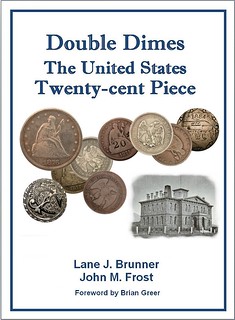 As announced in Gobrecht Journal #125 (Spring 2016), Lane Brunner and I confirmed two new die marriages of the 1876-P twenty-cent
piece. One new obverse and two new reverse dies were discovered in two new combinations, which is surprising given the total mintage of just 15,900
coins, including proofs!
As announced in Gobrecht Journal #125 (Spring 2016), Lane Brunner and I confirmed two new die marriages of the 1876-P twenty-cent
piece. One new obverse and two new reverse dies were discovered in two new combinations, which is surprising given the total mintage of just 15,900
coins, including proofs!
Lane and I have now completed Addendum 2 for the Double Dimes book and it is now posted for download on our www.doubledimes.com website. In addition, the website pages themselves have been updated to include these new die marriages, minor updates to one of the 1875-P listings (that reverse die was re-used in 1876), as well as a rewriting of the 1876-P Summary pages themselves.
This addendum is the second one created - we had previously announced in the spring 2015, the discovery of a new 1875-CC reverse die and die marriage, which was announced in the E-Gobrecht (Volume 11, Issue 4, Whole # 123, April 2015).
For those readers with the Print Edition of our book, both Addendum 1 and Addendum 2 are available for download and printing, so they can be included in your book (link addresses are shown below).
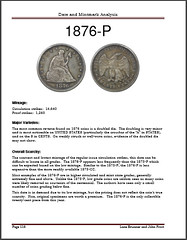
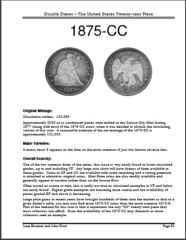
Addendum for 1876-P:
www.doubledimes.com/
DoubleDimeBook-Addendum-June2016.pdf)
Addendum for 1875-CC (and 1875-P BF-2):
www.doubledimes.com/
DoubleDimeBook-Addendum-March2015.pdf
For more information about the book, or to order, see:
www.doubledimes.com
To read the earlier E-Sylum article, see:
NEW BOOK: DOUBLE DIMES – THE U.S. TWENTY-CENT PIECE
(www.coinbooks.org/esylum_v17n31a02.html)
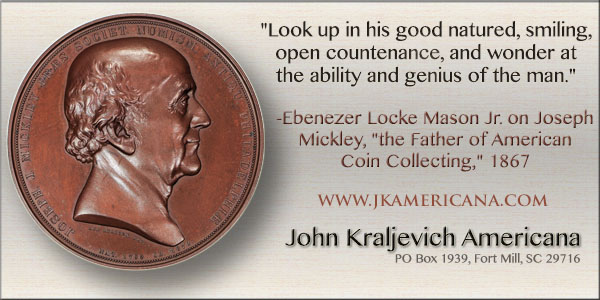
BOOK REVIEW: COIN COLLECTING ALBUMS VOLUME 2
I was pleased to discover that someone left a review of my new book on eBay. Evidently, eBay doesn't alert sellers when reviews are posted, so I stumbled across it while looking for something else.
Library of Coins as a Collectible
I bought this as a birthday gift for my son. He has a huge collection of library of coins albums. He very much enjoys the book, and says it
is a very good, long needed history and reference.
Coin Albums for the Boomer Generation
David Lange continues his magisterial coverage of vintage coin albums with this volume on the albums created by the Coin and Currency
Institute from about 1959 to the early 1970s.
Like Mr. Lange, I grew up in the San Francisco area and started collecting coins in the early-mid 1960s. Back around 1964 I discovered that both the big Woolworth's and the Emporium downtown carried coin and stamp supplies and indeed, coins and stamps themselves. While I soon learned that regular coin dealers had rather better prices for coins, the stores were convenient for buying supplies. Woolworth's had the Whitman Bookshelf albums. The rather more intimidating (to a youngster) Stamp and Coin Department at the Emporium featured the Library of Coins line.
Writing about coin albums is more than writing about coin albums. Lange explains how a couple of key entrepreneurs set up the stamp and coin franchises that eventually spread to several dozen department stores around the country, only to be done in by 1980 in the face of changing habits and unsustainable overhead. Just as Lange's first two volumes (on coin boards and the National coin albums) gave us a window into the growth of coin collecting as a more democratic pastime in the 1930s, the present volume takes us to the boom and bust of the 1960s, a time of transition as silver coins disappeared from circulation and a somewhat smaller base of collectors began to focus on older series.
As usual, Lange catalogs the albums thoroughly, including several editions and a number of variants, as well as the short-lived budget "Treasury of Coins" line. The book is profusely illustrated with vintage advertising and color pictures of the albums themselves. My only disappointment was the lack of pricing information. Mr. Lange said that basically there was no record to base pricing on (although he does talk about relative scarcity). However I would think that an analysis of the past few years of eBay listings would yield some useful information. At any given time a couple dozen or more of the albums are offered on the site. There are also a few online dealers in vintage coin supplies.
To summarize, this is a fine book indeed. We'll have to see if Lange's works spur a growth in album collecting as a numismatic sideline.
To read the complete article, see:
COIN-COLLECTING-ALBUMS-VOLUME-2-LIBRARY-OF-COINS-TREASURY-OF-COINS
(www.ebay.com/itm/COIN-COLLECTING-ALBUMS-VOLUME-2-LIBRARY-OF-COINS-TREASURY-OF-COINS-/322110632903)

BOOK REVIEW: THE BOOK
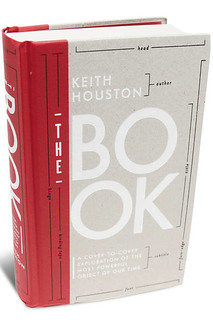 The Book
The Book
By Keith Houston
Norton, 428 pages, $29.95
Why are most printed books rectangular? One might imagine that it’s for ergonomic reasons—they’re easier to hold, carry and store. But according to Keith Houston, author of “The Book,” they have this shape “because cows, goats, and sheep are rectangular.” Two millennia ago, when the scribes of Pergamon in what’s now western Turkey stopped writing on papyrus scrolls and began to use sheets of parchment, they were creating a template for publishing—and a macabre one at that, since “a sheet of parchment is the end product of a bloody, protracted, and very physical process that begins with the death of a calf, lamb, or kid.”
“The Book” abounds with similarly graphic insights as it traces the history of this numinous object, beginning with the Egyptians’ invention of papyrus 5,000 years ago. Mr. Houston, a Scottish software engineer based in Edinburgh, has previously published “Shady Characters” (2013), a guide to the punctuation marks and typographical oddities that intersperse our daily lives. There he revealed twin enthusiasms: for probing the hidden stories of everyday phenomena, such as the @ symbol that appears in every email we send, and for rescuing from oblivion such curios as the back-to-front question mark known as the point d’ironie, devised by the French poet Marcel Bernhardt in the 1890s.
The same exuberance pervades “The Book”—and it needs to, for this is a volume crammed with technical information about matters that include binding techniques and the printing of devotional images as souvenirs for medieval pilgrims. There are nearly 70 dense pages of endnotes, and esoteric vocabulary swarms all around. The protective opening section of a roll of papyrus is a “protokollon”; the yellow pigment arsenic trisulfide is otherwise known as “orpiment”; a wrinkled piece of parchment is said to be “cockled”; and papermakers at one time employed a device called a “glazing hammer” for smoothing their wares. A chapter on bookbinding digresses into a discussion of the particularly odd-sounding “anthropodermic bibliopegy” (which involves books being bound in human skin).
Mr. Houston is an eager, affable guide, and his detailed history is a welcome reminder that this “unrepentantly analog contraption” is one of the truly great pieces of technology.
To read the complete article (subscription required), see:
From Sheepskins to E-Books
(www.wsj.com/articles/from-sheepskins-to-e-books-1472512842)
To read the earlier E-Sylum article, see:
THE MYSTERIOUS ANCIENT ORIGINS OF THE BOOK
(www.coinbooks.org/esylum_v19n35a24.html)

VANHOUDT WINS 2016 PNG FRIEDBERG AWARD
Friedberg Award Committee Chairman Jim Simek made the following presentation at the Professional Numismatists Guild annual awards banquet on August 8, 2016:
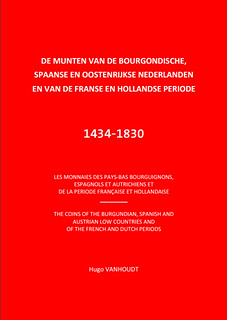 The Friedberg Award is the oldest of the many honors that the Professional Numismatists Guild confers. Inaugurated in 1963, the award is
named for distinguished numismatic writer and publisher Robert Friedberg. It is presented to an author judged to have produced a significant
numismatic work during the previous 12 months, though it has not been given every year.
The Friedberg Award is the oldest of the many honors that the Professional Numismatists Guild confers. Inaugurated in 1963, the award is
named for distinguished numismatic writer and publisher Robert Friedberg. It is presented to an author judged to have produced a significant
numismatic work during the previous 12 months, though it has not been given every year.
Several outstanding submissions were received this year, and the committee would like to thank each of the individuals who sent in their work for consideration. The decision, as is usually the case, was not an easy one to make.
This year's recipient is a gentleman from Heverlee, Belgium. His work is the product of many, many years of research and effort, and expands greatly and complements the last volume on the subject published in 1960.
Therefore, on behalf of the P.N.G., I am pleased to present the 2016 Robert Friedberg Award - for his work The Coins of the Burgundian, Spanish and Austrian Low Countries and of the French and Dutch Periods, 1434 to 1830 - to Hugo Vanhoudt. Our congratulations are extended to this worthy and very deserving individual.
This book seeks to complement and update the seminal work Les monnaies des Pays-Bas bourguignons et espagnols by H. Enno Van Gelder & Marcel Hoc (Amsterdam, 1960). It provides an overview of the centralized coinage in the Low Countries, from 1434 to 1830. The first year is based on the Ordinance of January 23, 1434, whereby Philip the Good organized a uniform coinage in his territories — the latter year coincides with the end of the common coinage under William I, King of the United Netherlands, due to the proclamation of the independence of Belgium in 1830.
Administratively, Philip the Good’s territory was larger than the territory of the current Netherlands and Belgium combined. Since the souvereign usually stayed in Flanders or Brabant, they spoke of ‘countries hither about’ or ‘les pays de par deça’, being the surrounding and adjacent areas, and the ‘countries thither about’ or ‘les pays de par dela’, being the Burgundian territories in France.
The coinage in the Low Countries is described here in the broadest sense with regard to the administrative territory (including Burgundy), and includes all the official emissions made by the reigning monarch, the obsidional coins in this period, and other special emissions such as piedforts, presentation coins, etc. The aim is to combine as much information as possible in this work. Additions and corrections to this book will be available at www.hugovanhoudt.be.
This book is the result of years of effort and could not have been brought to a good end without the help of many people who have assisted me in several ways, even small, by letting me visit their collection, by providing me information and illustrations, etc.
My most sincere thanks go to the many numismatists, collectors and public institutions which have helped me, and especially to Mr. Jan Moens, who has displayed an inexhaustible energy in attacking the many layout tasks I have given to him; without him, this book would never have been published.
For more information, or to order the book, see:
www.hugovanhoudt.be
For more information on PNG, see:
http://pngdealers.org/
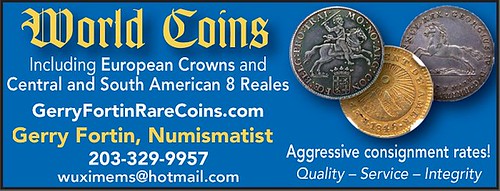
NEWMAN PORTAL DIGITIZES APFELBAUM RARE COIN COURSE
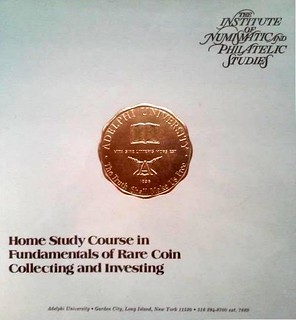 In 1978, the attorney and telemarketer Stanley Apfelbaum created the Institute of Numismatic and Philatelic Studies at Adelphi University
in Garden City, New York. In addition to live classes, Apfelbuam created a home study version of the course that consisted of 20 cassette tapes and a
syllabus. With the permission of Adelphi University, these tapes have been digitzed by the Newman Portal and include speakers such as Harry Forman,
Walter Breen, Herbert Melnick, John J. Ford, Jr., and Apfelbaum himself. David Alexander summed up the course in a revealing article published by
Coin Week on January 13, 2016:
In 1978, the attorney and telemarketer Stanley Apfelbaum created the Institute of Numismatic and Philatelic Studies at Adelphi University
in Garden City, New York. In addition to live classes, Apfelbuam created a home study version of the course that consisted of 20 cassette tapes and a
syllabus. With the permission of Adelphi University, these tapes have been digitzed by the Newman Portal and include speakers such as Harry Forman,
Walter Breen, Herbert Melnick, John J. Ford, Jr., and Apfelbaum himself. David Alexander summed up the course in a revealing article published by
Coin Week on January 13, 2016:
“A number of prominent numismatists, FCI [First Coinvestors Inc.] staffers and hobbyists flocked to take the courses offered, taught by such professionals as Walter Breen and Anthony Swiatek. Breen appeared in flip-flops, tie-dyed shirts and his usual unwashed shorts. Registrants received an elaborate certificate of participation that was impressive to gaze upon. Unfortunately, it soon became obvious that a primary (but unspoken) purpose of courses and certificates was to certify FCI telemarketing salesmen as qualified numismatists!”
The tapes portray a different time, when investing in rare coins captured a much great mindshare of the hobby than it does today. The spoken voice reveals more character than the written word, and listening to Melnick, et al, one is transported back in time to another era when millions of households had made a few dollars for themselves simply by saving silver coins. The idea of making even more money was understandable and attractive, and Apfelbaum did his best to leverage a susceptible public.
Note: this group of cassettes was stored in variable conditions for a great period of time, and audio quality varies. The John J. Ford, Jr. tapes in particular are difficult to understand. The Newman Portal will gladly digitize another set if a reader is willing to loan them.
Thanks to our library partners at Washington University in St. Louis and their counterparts at Adelphi University for making this digital archive possible. -Editor
Link to audio recordings of the Institute of Numismatic and Philatelic Studies:
https://archive.org/details/newmannumismatic?and%5B%5D=mediatype%3A%22audio%22&sort=-date&and%5b%5d=Adelphi
Link to Coin Week article by David Alexander on Stanley Apfelbaum:
http://www.coinweek.com/education/numismatic-history-stanley-apfelbaum-coin-telemarketing/
PRICED AND NAMED EDWARD MARIS CATALOG SOUGHT
Ray Williams writes:
Does anyone have a priced and named Stan Henkels Edward Maris auction catalog? A friend emailed me with an inquiry, which reminded me of some research I started (and gave up on) some years ago.
Ray adds:
The sale was cataloged by Maris himself. Each New Jersey Copper was auctioned individually. After the last NJ was sold, the total of
all the hammer prices was calculated and the intact collection was offered for bid starting at that price. John Work Garret was the
successful bidder. The Garrett NJs ended up at Johns Hopkins University and were sold by Bowers & Ruddy (minus the coins Dick Picker
cherry-picked from the collection). The Henkels auction was conducted June 21, 1886.
Ray also sent a link to a recent Kolbe & Fanning sale of a Henkels Maris catalog. Here's an excerpt.
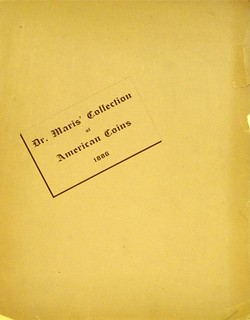 The October 1886 issue of the American Journal of Numismatics reported that, "although the name of a New York dealer [Smith]
was placed on the title page, that gentleman did 'not own a single piece in it,' and Dr. Maris was 'driven to the necessity of placing it
there by the attitude of other dealers, who protested against a collector cataloguing his own collection.'" Smith's name appears on the
separately printed Preface, but only at the bottom of the title page of the catalogue itself (which reads "With the Compliments of H.P.
Smith"); and on most copies seen, even that line is lacking.
The October 1886 issue of the American Journal of Numismatics reported that, "although the name of a New York dealer [Smith]
was placed on the title page, that gentleman did 'not own a single piece in it,' and Dr. Maris was 'driven to the necessity of placing it
there by the attitude of other dealers, who protested against a collector cataloguing his own collection.'" Smith's name appears on the
separately printed Preface, but only at the bottom of the title page of the catalogue itself (which reads "With the Compliments of H.P.
Smith"); and on most copies seen, even that line is lacking.
Charles Davis, in his catalogues of the Champa library, has suggested that it was the Chapman brothers who protested at Maris preparing his own catalogue, noting that they ceased holding their auction sales at Henkels shortly after this sale. Smith's Preface acknowledges "material assistance from the owner, in the preparation of the Catalogue." (There are also references throughout the sale referring to Maris in the third person, though these may have been written by Maris.)
Smith discusses the issue of plated catalogues, stating that "I have had 50 Catalogues made, containing six plates." It is generally felt that far fewer than this were issued, as the number of surviving copies has been estimated as fewer than ten. The New Jersey coppers were purchased en masse by T. Harrison Garrett through his agent Harold Newlin for $551 (he had been offered the collection directly by Maris for $1000 earlier). One of the most important sales of the 19th century.
To read the complete lot description, see:
The Maris Sale, with Preface and Circular
(www.icollector.com/The-Maris-Sale-with-Preface-and-Circular_i22956866)
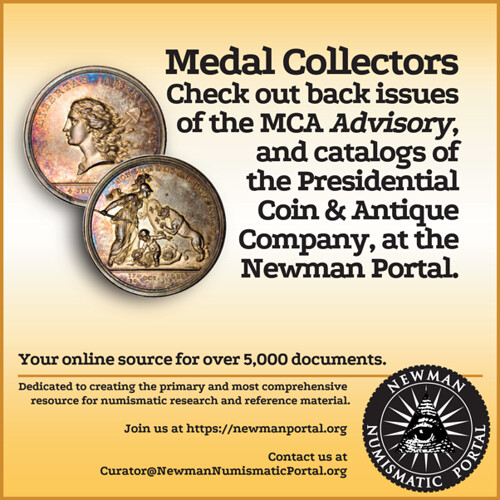
MORE ON SAXTON'S 1839 PHOTO FROM THE U.S. MINT
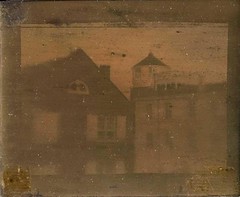 Further information concerning Joseph Saxton’s 16 October 1839 photograph taken from the U.S. Mint may be found in a publication written by
Arthur H. Frazier: Joseph Saxton and His Contributions to the Medal Ruling and Photographic Arts. City of Washington: Smithsonian Studies in
History and Technology, Number 32, 1975. [Kolbe Library 448].
Further information concerning Joseph Saxton’s 16 October 1839 photograph taken from the U.S. Mint may be found in a publication written by
Arthur H. Frazier: Joseph Saxton and His Contributions to the Medal Ruling and Photographic Arts. City of Washington: Smithsonian Studies in
History and Technology, Number 32, 1975. [Kolbe Library 448].
Frazier cites an 1892 article as the source of the numismatically rather fascinating assertion that a silver plate, from which coin planchets were cut, was utilized for the 1839 photograph and further notes that “(a) combination of Saxton’s medal ruling and daguerreotype skills helped to produce a remarkable illustration of the second United States Mint, which was published in 1842 in Eckfeldt and Du Bois’ Manual of Gold and Silver Coins.”
Frazier further states that Saxton’s 1839 daguerreotype is “one of the first ever made in this country and the oldest extant American picture by any photographic process… Historically, it is one of the most famous pictures in all of American photography.”
To read the earlier E-Sylum article, see:
JOSEPH SAXTON'S 1839 PHOTO FROM THE U.S. MINT
(www.coinbooks.org/esylum_v19n35a16.html)
U.S. MINT PLANS COIN FORUM OCTOBER 13, 2016

The U.S. Mint has announced that it will hold a Numismatic Coin Forum in Philadelphia on Thursday, October 13. The one-day conference aims to prepare for the Mint’s upcoming 225th anniversary by bringing together various members of “stakeholder” organizations to discuss the past, present, and future of numismatics.
A press release notes that U.S. Mint Principal Deputy Director Rhett Jeppson said of the upcoming forum, “It seems only appropriate that, while we as a bureau are celebrating our history, the Mint is also looking for ways to improve the way we engage our customers and invigorate our relevance into the future.”
While the event is not open to the public, individuals can request admission via email at USMintNumismaticForum@usmint.treas.gov; the deadline for consideration is September 15, 2016. Formal presentations offered during this forum will be posted online soon afterward. For more information on the Mint’s requirements for admission requests, please visit its Web site.
To read the complete article, see:
U.S. Mint Plans Coin Forum to
Share Perspectives on Numismatic Hobby
(http://news.coinupdate.com/u-s-mint-plans-coin-forum-to-share-perspectives-on-numismatic-hobby/)
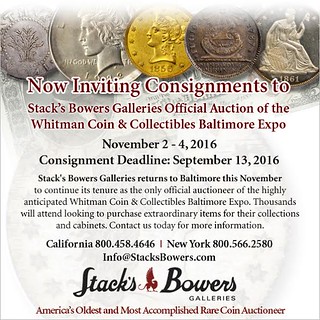
NOTES FROM E-SYLUM READERS: SEPTEMBER 4, 2016
Correction Corrected
As it turns out, it was David Lange's NLG award plaque that was incorrect. Dave writes:
Ed Reiter clarified that the NLG website is correct and it's my plaque that's wrong. I did, in fact, receive an Extraordinary Merit award for my Coin Collecting Albums, Volume 2 book, but my plaque was incorrectly engraved. In fact, I'm thinking of having it slabbed as a rare error variety.
To read the earlier E-Sylum articles, see:
NOTES FROM E-SYLUM READERS: AUGUST 28, 2016 : Correction: Lange NLG Awards
(www.coinbooks.org/esylum_v19n35a14.html)
2016 NLG WRITERS’ COMPETITION RESULTS
(www.coinbooks.org/esylum_v19n34a06.html)
New Subscriber: Shaul Ladany
Bill Rosenblum writes:
Another excellent issue as usual. I was reading the story about the Olympic Medal winners yesterday and lo and behold I came across the name of Shaul Ladany. I said Wow! I know him.
Shaul Ladany, among his many, many accomplishments, is also of collector of coins, medals, tokens, stamps and the like. I had known about some of his life and how he was the first to notify outside sources of the attack in Munich. But I had not known that he was a winner of the Pierre de Coubertin Medal. He also still holds many age-group "walking" records including a few in New Jersey when he was a professor at Princeton. I believe he still competes!
I asked him if it was ok to let me know about one of his many hobbies. He not only gave me permission to pass it on, he wanted to become a subscriber.
To read the earlier E-Sylum article, see:
THE PIERRE DE COUBERTIN OLYMPIC MEDAL
(www.coinbooks.org/esylum_v19n35a34.html)
On Coin Thickness
Gary Beals writes:
I bought a late 1700s Russian Kopek recently and was amazed at how much thicker it was than the Groat of the 1400s. Here is a shot that will be in El Numiscadero -- with fingers volunteered by my lovely wife Maureen.
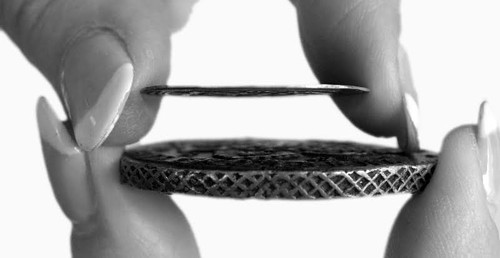
On Short Snorters
On another topic, Gary Beals writes:
That banknote with Edison writing on it seems like a Short-Snorter note to me.
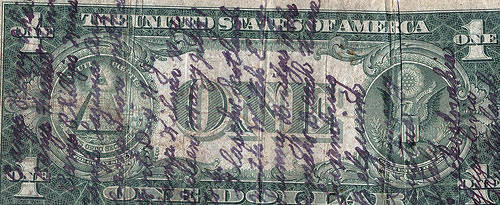
Short Snorter signed by Mercury astronauts
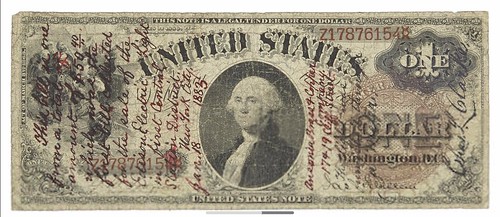
First dollar made by Edison Electric Light company
To read the earlier E-Sylum article, see:
SELECTIONS FROM BONHAM'S CAREN ARCHIVE SALE
(www.coinbooks.org/esylum_v19n35a21.html)
Open Queries: Numismatist Reprints and Browning Plates
Numismatist Reprints Before 1900
To read the earlier E-Sylum article, see:
QUERY: REPRINTS FROM THE NUMISMATIST BEFORE 1900
(www.coinbooks.org/esylum_v19n32a19.html)
Browning Quarter Plates
To read the earlier E-Sylum article, see:
QUERY: BROWNING QUARTER PLATES INFORMATION SOUGHT
(www.coinbooks.org/esylum_v19n32a18.html)
A Golden Reward for Not Smoking or Drinking
Bob Leonard writes:
I'm a member of the Weston (Missouri) Historical Museum, which I joined many years ago when I thought that the M. A. Abrahams tokens reading Weston were from there and not, as it turned out, from Westport. I receive their quarterly newsletter, Museum Musings.
In the July-August-September issue, p. 4, is the following item:
The Weston Chronicle dated May 26, 1900 reported "Several years ago, Sheriff John Dillingham's first wife promised their five sons that if they would not use tobacco or strong drink until they were twenty-one years of age, she would give each the sum of $100.00 as a gift on his twenty-first birthday. Wednesday, William Dillingham reached his majority and as he had faithfully kept the promise, his father, Sheriff Dillingham, presented him with five $20.00 gold pieces."
Wow!

ONLY QUARTERS AND HALF EAGLES COINED IN 1815
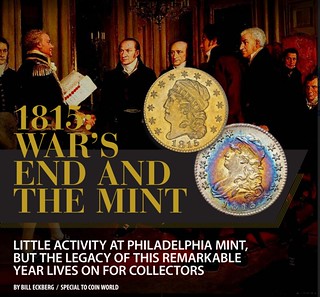 Some of the information in the lot description of the 1815/2 half dollar quoted in last week's E-Sylum is outdated.
Only half eagles and quarters were coined in 1815. [Emphasis mine - Editor] All of the 1815-dated halves and 20,003 of the quarters
were coined in the first 10 days of 1816. Right after that a fire destroyed the Mint’s rolling mills, and no more silver or gold could be
coined until they were replaced in 1817. All of the silver coins minted in 1816 were dated 1815.
Some of the information in the lot description of the 1815/2 half dollar quoted in last week's E-Sylum is outdated.
Only half eagles and quarters were coined in 1815. [Emphasis mine - Editor] All of the 1815-dated halves and 20,003 of the quarters
were coined in the first 10 days of 1816. Right after that a fire destroyed the Mint’s rolling mills, and no more silver or gold could be
coined until they were replaced in 1817. All of the silver coins minted in 1816 were dated 1815.
The mistaken belief that cents were coined in 1815 apparently originates in a report by Director Patterson that probably amounts to bureaucratic butt-covering but has been repeated by a number of expert authors over the years. The Treasurer’s records clearly show that no cents were coined between October of 1814 and January of 1816. Cent coinage presumably began during the week of January 15 (Mint records are not clear on the exact date), if we give the Mint personnel a few days to clean up after the fire. Interestingly, the cents coined in January and February of 1816 were all dated 1814.
Information supporting this can be found in two articles. The first was in Coin World, and the second in Penny-Wise, both published in 2015. If you read carefully, you will notice that the CW article repeats the old, common error that cents were struck in 1815. After it was published, I recognized the error in that thinking.
All of which shows why it is far more important to look at and trust actual data rather than received knowledge. Evidence-Based Research is far superior to Eminence-Based Research.
To read the earlier E-Sylum article, see:
ELIASBERG 1815 OVER 2 HALF DOLLAR
(www.coinbooks.org/esylum_v19n35a18.html)
THE 40-YEAR JOURNEY OF TWO HALF DOLLARS
The following article was published in the New York Sun, October 1st, 1897, under the title, “Two Persistent Half Dollars, Stamped and Set Adrift in 1856, They Return to Tickle Their Former Owner.” This article was picked up by corresponding newspapers and published by a number of different newspapers including…
Mariposa Gazette (California), November 13, 1897
ERRANT HALF DOLLARS. Sent Adrift Forty Years
Ago, They Return to Their Former Owners….
One day in the summer of 1856, when Albert George and Humphrey Pinhorn of the village of East Orrington, Maine, were in Bangor marketing, they received two half dollars fresh from the mints. As both were young men with plenty of money for their immediate wants they stamped their initials in stencil upon the new coins and took them to a hotel where they exchanged then for two dinner. In the LincolnDouglas campaign of 1860 the two young men, who had become voters, joined the Wide Awakes, a political organization that paraded the town with torchlights. One evening after a parade in Rockland they went out to supper, and in exchange for a bill paid to the cashier Pinhorn received a half dollar marked “H.P.” It was the coin he had sent adrift four years before.
The war came on, and both of the young men enlisted, following the fortunes of the Twenty-second Maine regiment. For five or six years after the war there was no silver or gold in circulation, and nothing was seen of the marked coins until the GarfieldHancock campaign of 1880. Then Mr. George received the half dollar marked “H.P.” in exchange for beef which he had sold. He turned it over to Mr. Pinhorn, who paid it out for tobacco at the local store. After that the “H.P.” half dollar returned frequently. Mr. Pinhorn got it in 1882, Mr. George in 1884 and again in 1885 and Mr. Pinhorn in 1886. In 1888 Mr. Pinhorn had it three times and in 1891 Mr. George received it and paid it out four times. It was taken in by Mr. George in 1894, after which it made a sojourn in other parts.
Meantime, Mr. George grew anxious about the half dollar which bore his initials and advertised, offering $5 for its return to him. Several spurious imitations of the real article were sent in and promptly returned, as the stencil marks were not made in the right kind of type. Though he kept an advertisement standing in all the local papers and in two of the Boston dailies for nearly a year he received no tidings of what he wanted.
The other day he went to a Bangor bank to get his pension check cashed, and in the money which the cashier passed out were two half dollars. Upon the face of one were the old initials, “H.P.” and on the other were the letters of his own name, “A.A.G.”. It was the long lost half dollar which he had stamped and spent for dinner in 1856 and for which he had been offering a reward. Mr. George has framed his half dollar and hung it up over his desk, with orders to have it placed in his coffin. The coin marked ”H.P.” was turned loose again to go out and make history for itself—New York Sun
The LSCC provides the information contained in this email newsletter from various sources free of charge as a general service to the membership and others with this numismatic interest. You do not have to be a LSCC member to benefit from this newsletter; subscription to the E-Gobrecht is available to anyone.
To be added or removed from the E-Gobrecht mailing list, send an email message with the words "Subscribe/Unsubscribe" in the subject line of the message to: wb8cpy@earthlink.net.
For more information about the Liberty Seated Collectors Club., see:
www.lsccweb.org
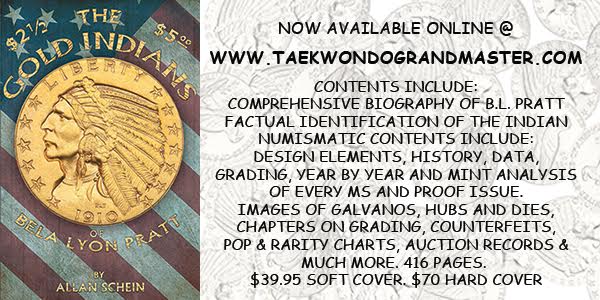
LUTHER C. BRYANT (1801-1886)
Luther C. Bryant (1801-1886), was a New York coin and stamp dealer and is also known as the wayward cousin of the famous American poet William Cullen Bryant. His consanguinity to William Cullen Bryant, however, is not certain and doubtful. It is strange and a rather odd coincidence that many details given by Luther Bryant about his life seem to fit that of William Cullen Bryant, but for himself none of them are corroborated except for his life in New York working as a coin and stamp dealer and the valuable furnishings and possessions he amassed. The remaining details are claims made by Luther Bryant about himself and his life prior to New York made to various journalists who were eager to write about him following the sensational report of his being robbed of $120,000.
According to his own account he was born in Cummington, Hampton County, Massachusetts, son of a physician. He studied at Williams College and became a physician with a practice in Burlington, Vermont. He left as an act of protest during the Mexican War in 1848 to go south. He settled at Charleston, South Carolina and worked as a physician there but fled north at the outbreak of the Civil War arriving in New York in 1861. However, according to the New York City Directory, 1886, a Luther C. Bryant, physician is listed and reported living at 742 Greenwich Street. One wonders if anything about this man is true except for his coin and stamp dealership which was well known and attested to, as well as his ring of artful dodgers he formed in a postage stamp pilfering scheme.
He lived in a two room rear apartment on the third floor of a tenement house in the poor district at 1 Forsyth Street and traded as a Coin Dealer at Fulton Street, New York, and Nassau Street, New York. His stand on Nassau Street was very well-known to New Yorkers where he sold old stamps, coins and medals, a dealer contemporary with John K, Curtis. Bryant traded in old coins and medals from 1861 until 1874. If it was not for his ill fate this obscure dealer would have been lost to posterity.
When he arrived at New York in 1861 he behaved somewhat like a carpetbagger. He purportedly brought with him more than $60,000 of which $45,000 was in gold coins. Since the Civil War brought on a scarcity of gold its valued rose dramatically and we find Bryant began to sell his gold coins at a profit. He began buying and selling gold coins, old coins, medals, postage and revenue stamps, broken bank bills, and so on in City Hall Park. But when construction for the Post Office Building began in August 1869 he was forced to move in front of the Old Dutch Church, corner of Fulton and William Streets.
What made Bryant famous was his robbery. He was robbed of $120,000 in gold, cash, coins, and other valuables during the night on October 11, 1874 by a well contrived scheme. He had $20 gold pieces saved since 1862 in thirty-five rolls of 100 pieces each rolled up in silk paper, $70,000 in face value. His aunt left him a 200-acre farm and $7,000. He also collected valuable china, hand woven carpets imported from Brussels, chromo paintings, bronze sculptures, antique carved furniture, jewelry, and bank notes. Yet despite his great wealth he chose to live as a Fagin-like miser in the slums of New York.
Following Parson's noteworthy essay "William Cullen Bryant's Wayward Cousin" (1950), Luther Bryant appears as a true to life antagonist character out of Dickens' Oliver Twist. Apparently, Bryant enticed young errand boys to steal postage stamps from business offices by trading disreputable racy dime novels for them. His scheme was discovered by a New York Detective, George Roscoe of Davies Detective Agency, who was hired by Eberhard Faber, the lead pencil manufacturer, to discover who was stealing his postage stamps. Once his errand boy Charley Krepps was discovered giving Bryant sheets of stamps Bryant was arrested on Wednesday, October 7, 1874, and sent to "The Tombs" the nickname given to the prison attached to the Police Court.
While in prison he sent a note to his neighbor, Mary Reynold to keep watch on his apartment's locked door. The Sunday following Bryant's arrest another neighbor coming home late at night observed a carriage rush away from the building and found Bryant's apartment had been broken into, ransacked and robbed. The burglars seized $20,000 in postage stamps that were locked in a trunk, $70,000 in gold coins rolled up in paper, pearl handled revolvers, pearl handled umbrellas, jewelry, antiques and art works, and other valuables totaling $120,000.
Weeks of investigation by New York Police discovered Robert Murray, alias "Bobby the Welshman" and George "the Rat" Reilly were responsible for the break-in and robbery. They were tried and sentenced but the money and other valuable, except for the umbrellas and a revolver were recovered.
Since Bryant was left destitute and the various New York firms robbed of their postage stamps saw no means of recovery Bryant was set free and the charges dropped.
While in prison he was visited by Lizzie Neubauer, a young woman of 18 years whom he proposed marriage to at the age of 73. She refused to marry him but took his furniture and other valuables. The Neubauer loot was recovered and she and her mother Sophia were sentenced to prison as well.
So who was Luther Bryant? We only know for certain that he was a New York coin and stamp dealer who amassed a fortune, some it acquired through corruption, and all lost in an night. He died a pauper and blind. And so it seems he was always blind.
To read the complete article, see:
BRYANT, LUTHER C
(https://sites.google.com/a/numismaticmall.com/www/numismaticmall-com/bryant-luther-c)
Kay Olson Freeman kindly provided additional research on last week's featured bio on Ohio dealer Jacob Postley. For one thing, he had changed his name from Jacob Poznanski in 1889. I forwarded her write-up to John Lupia. -Editor
John writes:
Many thanks to Kay. I suspected something like this.
To read the earlier E-Sylum article, see:
JACOB POSTLEY (1861-1937) (www.coinbooks.org/esylum_v19n35a17.html)

THE TWO DOLLAR BILL DOCUMENTARY

Shot in a dozen states over the course of a year, The Two Dollar Bill Documentary was a passion project for its Director, John Bennardo, when he decided to learn more about the small stack of $2 bills he had stashed in his desk drawer. Little did he realize how much his film would grow conceptually; what started out as a history lesson with some small anecdotes and hidden camera uses of the bill became a thoroughly comprehensive story whose content was as inspirational as it was informative.
The project was legitimized when Bennardo was given permission to film the production of two dollar bills at the Bureau of Engraving and Printing in Fort Worth, Texas. Soon after, the film was mentioned in a New York Times article about the revitalization of the $2 bill. The article caught the attention of several individuals with various stories related to the $2 bill. They in turn contacted Bennardo to be a part of the film. How could he leave out Treasury employees involved in the re-issue of the $2 bill in 1976? Or, stories of the $2 bill on NASA space missions? The scope of the project grew, and Bennardo wanted to document all of it.
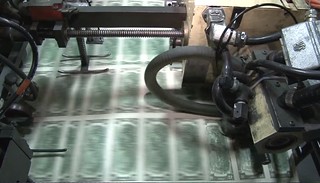 The project then took a full year for editing, with the most difficult task becoming how to weave all the fascinating information into a
cohesive narrative. For that, Bennardo turned to his own personal story, supplemented by research data provided by interviewee Erik Mintz, to frame
the film. The result is a stirring success: The Two Dollar Bill Documentary is a fun, entertaining and informative look at a piece of currency that
is so much more than meets the eye. Audiences have come away surprised, not only at how the film exceeded expectations, but how much information they
learned from the film. Bennardo is confident that the film will invigorate awareness and use of the denomination—or at least will have people
searching for their own stashed bills for another look.
The project then took a full year for editing, with the most difficult task becoming how to weave all the fascinating information into a
cohesive narrative. For that, Bennardo turned to his own personal story, supplemented by research data provided by interviewee Erik Mintz, to frame
the film. The result is a stirring success: The Two Dollar Bill Documentary is a fun, entertaining and informative look at a piece of currency that
is so much more than meets the eye. Audiences have come away surprised, not only at how the film exceeded expectations, but how much information they
learned from the film. Bennardo is confident that the film will invigorate awareness and use of the denomination—or at least will have people
searching for their own stashed bills for another look.
Synopsis When a child’s tooth falls out, the odd, quirky $2 bill is usually called on as the best gift from the Tooth Fairy. But aren’t they hard to come by? When a young boy’s father tries to find the perfect $2 bill for this occasion, he begins a journey that enlightens him about the denomination most people know nothing about.
The quest starts with confirmation that urban legends about the $2 bill—one involving a Taco Bell manager and another about a man who got arrested for using them at a Best Buy—are real. A meeting with a blogger who documents reactions to $2 bills reveals that people are fascinated when they see one because of the misconception that they’re rare or aren’t printed anymore.
Not so! At a visit to the Bureau of Engraving and Printing in Fort Worth, Texas, we learn how they’re made, how often, and we see the 2013 Series being printed firsthand. The “intaglio” print design is prominent on the twos, which have a rich history dating back to the thousands of “broken-bank” twos made before the Civil War. The history lesson takes us through the red-seal Monticello bills, which were discontinued in 1966, and then to the re-issue in 1976, which was so beautiful that people thought it a collector’s item. The bill was hoarded, passed onto to future generations, or held for good luck.
The bill has been considered a novelty and treated this way since 1976, but the misconceptions surrounding it have made for some touching stories about the ways it connects people. Furthermore, consumers and vendors who employ the bill (including strip clubs) find it to be an effective tool for engagement. Even special interest groups use the bill to create awareness about their message. Clemson University, whose alumni stamp twos with tiger paws before bowl games, are an example.
Some believe the $2 bill to be good luck, including astronauts who have taken them onto numerous space missions. Others, however, believe the bill to be cursed. A superstition expert shows us how the Illuminati may have placed hidden symbols and messages on the deuce, as well as the ways you can remove the curse.
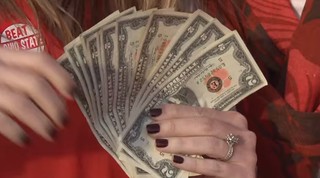 Other misconceptions about the bill include the idea that it is worth more than two dollars. Visits with collectors and currency experts
show this not to be true, but there are some cases when the bill has added value. Even at two dollars though, there is a large subculture of people
who cherish the bill, and its uses in society are grossly underestimated. One powerful story about a widow from the September 11 tragedy shows this
emphatically.
Other misconceptions about the bill include the idea that it is worth more than two dollars. Visits with collectors and currency experts
show this not to be true, but there are some cases when the bill has added value. Even at two dollars though, there is a large subculture of people
who cherish the bill, and its uses in society are grossly underestimated. One powerful story about a widow from the September 11 tragedy shows this
emphatically.
With all this knowledge, will one father gift his 7-year old a $2 bill from the Tooth Fairy, or is there a better way for him to receive it? After a memorable journey to document the bill, the decision has been made very clear.
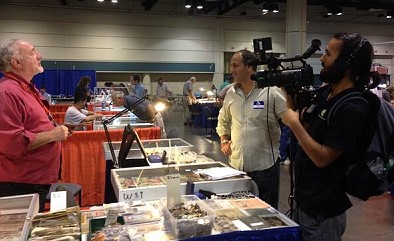
To read the complete CoinWeek article, see:
“TWO DOLLAR BILL DOCUMENTARY”
NOW IN PRODUCTION (www.coinweek.com/paper-money-2/paper-money-us/two-dollar-bill-documentary-now-production/)
For more information, see:
www.2dollarbillmovie.com
CERTIFYING THE D.B. COOPER RANSOM BANKNOTES
Donn Pearlman writes:
I read the story about the DB Cooper note in the last edition of The E-Sylum. I was present at PCGS Currency headquarters when the notes were being examined, and in some cases, pieced together like a jig-saw puzzle. I shot photos, and thought these would be interesting for your readers.
Nearly two dozen $20 denomination notes from the infamous 1971 “D.B. Cooper” skyjacking have been certified by PCGS Currency on behalf of the owner who found them a quarter-century ago. The bills belong to Brian Ingram, 36, of Mena, Arkansas who was eight years old in 1980 when he found the only ransom cash ever recovered from the infamous skyjacking.
“Even though the notes were damaged from apparently being in the Columbia River for years, we were able to match serial numbers with those on the FBI’s list of the $200,000 in $20 bills the skyjacker had when he jumped from the jetliner. There was even a Series 1963A star note,” said Laura A. Kessler, Vice President of PCGS Currency (www.PCGSCurrency.com) ... who headed the certification team
Brian Ingram & D. B. Cooper Notes
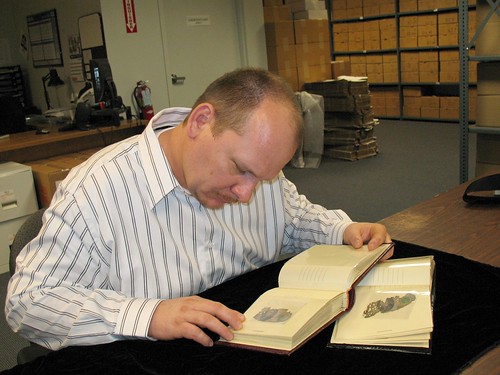
Brian Ingram of Arkansas, who at the age of eight in 1980 found the only ransom money ever discovered from the legendary 1971 “D.B. Cooper” skyjacking, looks at the recovered $20 notes he’s stored for decades in photo albums. He brought the historic notes to PCGS Currency for certification on February 11, 2008. (Photo credit: Donn Pearlman)
FBI Agent’s initials on recovered “D. B. Cooper” note
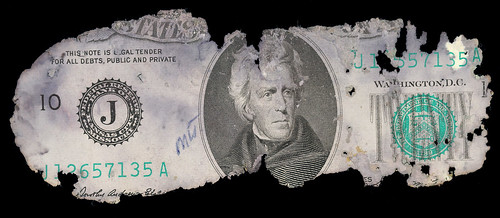
An FBI agent's initials are visible to the left of the portrait on this recovered Series 1969 $20 note (with back plate number 86) from the infamous 1971 “D.B. Cooper” skyjacking ransom. The FBI inventoried and analyzed this and other notes found along the Columbia River near Vancouver, Washington by an eight year old boy on vacation with his parents in 1980. (Photo credit: Phil Arnold/Collectors Universe)
D. B. Cooper Note Fragments
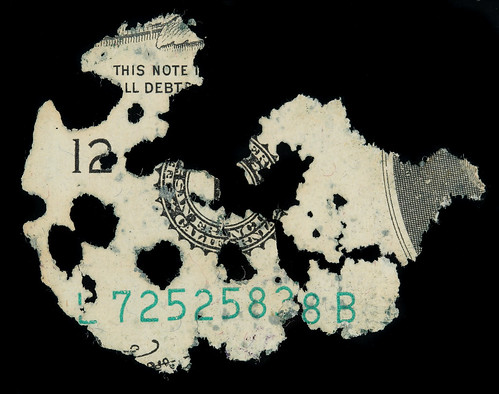
It was “PCGS C.S.I.” as fragments of the “D. B. Cooper” ransom notes were carefully pieced together to reveal apparently previously unrecorded serial numbers. (Photo credit: Phil Arnold/Collectors Universe.)
Laura A. Kessler carefully holds a DB Cooper note with tweezers
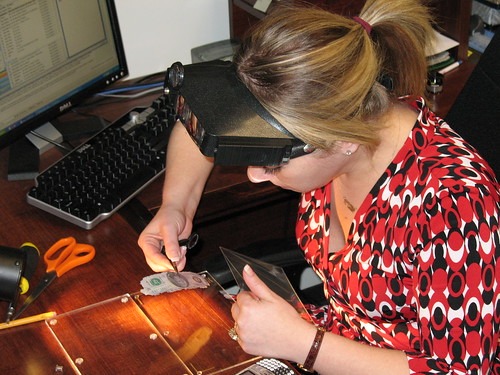
In February 2008, PCGS Currency Vice President, Laura A. Kessler, began the examination of “D. B. Cooper” 1971 skyjacking ransom money, carefully holding one of the recovered $20 notes with tweezers. (Photo credit: Donn Pearlman.)
Laura A. Kessler, Brian Ingram & Jason Bradford
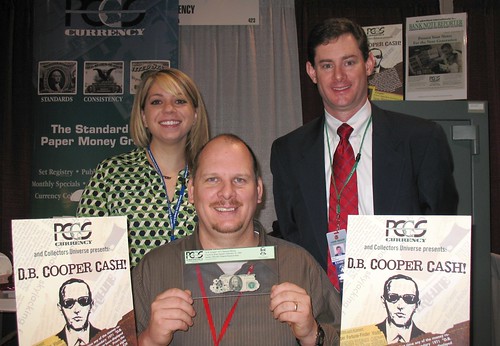
Brian Ingram of Arkansas holds a “D. B. Cooper” 1971 skyjacking ransom $20 note he found when he was eight years old. Standing behind him at the February 2008 Long Beach Expo are PCGS Currency Vice President, Laura A. Kessler, and President Jason Bradford. (Photo credit: Donn Pearlman)
Donn Pearlman & D. B. Cooper
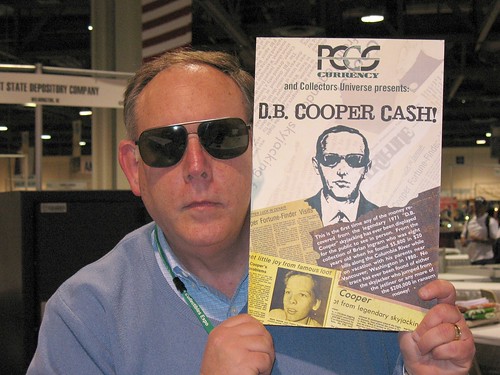
Some people think former ANA Governor Donn Pearlman resembles the skyjacker known as “D. B. Cooper.” Coincidence? (Photo credit: Jason Bradford/PCGS Currency.)
To read the complete 2008 Press Release see:
PCGS Currency Certifies Legendary
“D.B. Cooper” Skyjacking Ransom Notes (www.pcgs.com/News/Pcgs-Currency-Certifies-Legendary-Db-Cooper-Skyjacking-Ransom-Notes)
To read the earlierE-Sylum article, see:
D.B. COOPER RANSOM BANKNOTE OFFERED
(www.coinbooks.org/esylum_v19n35a35.html)

2016 TOKEN CONGRESS OCTOBER 7-9, 2016
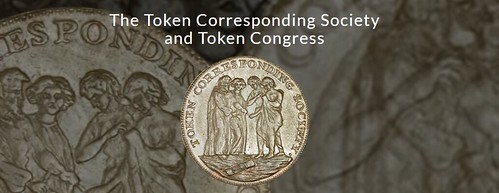
Gary Oddie of the Token Corresponding Society writes:
It is getting close to the deadline to sign up for this year's Token Congress which will be held in Northampton between 7-9 October 2016. Details as follows:
"The 2016 Token Congress will be held at the Hilton Hotel, Northampton on 7-9 October. The organiser is John Newman. It will follow the usual Friday afternoon to Sunday morning format. Further details for signing up can be had via the link on the Token Corresponding Society Website."
Over 90 people have already signed up including several from the USA who are combining the visit with the Coinex fair and several auctions in the previous two weeks.
Token Congress was initiated in 1982 by Brian Edge, to cater specifically for token collectors and organised along the lines of the well established BANS Congress, (British Association of Numismatic Societies). This initial Token Congress at Crewe was the start of an annual event and membership has grown ever since.
There is no formal committee to run the Society, but policy decisions, as the need arises, can be made at Token Congress each year where many of the subscribers meet.
For more information, see:
http://thetokensociety.org.uk/
MCA ADVISORY JULY/AUGUST 2016 ISSUE PUBLISHED
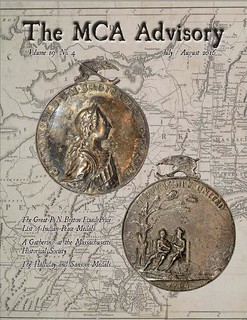 In This Issue
In This Issue
President’s Message
Introduction by the Editor
Letters to the Editor
• • • • • • • •
The Great Breton Fixed Price List submitted by Joe Foster
Is It Fine Art or Factory Art? by D. Wayne Johnson
Antonio Pisanello vs. Matteo de Pasti by Lev Tsitrin
A Visit by Fernando Chao
An Account of a Gathering at the MHS by Anne Bentley
The Halliday and Sansom Medals an excerpt from Medallic Washington by Neil Musante
Jorge N. Ferrari – an appreciation by John W. Adams
Medal Collectors of America
Medal Collectors of America was founded in 1998. Its purpose is to foster the collection and study of world, American art and historical
medals. Our goal is to encourage research and publication in the medal field, while bringing together all who are interested, through
meetings, publications and activities. Our print Advisory is published six times a year and we encourage submission of articles with
original research. It is also available electronically. We maintain an exceptional website at www.medalcollectors.org, and encourage
everyone to visit the site to learn more about the organization. We hold two meetings a year featuring guest speakers on a wide range of
topics relating to medal collecting. One is held in August in conjunction with the American Numismatic Association convention, and the
second in January, in conjunction with the New York International Numismatic convention. Meetings are open, and all are encouraged to
attend.
Annual Membership Dues:
$ 55/year Printed Edition or $ 50/year Multiple Years Hard Copy
$ 25/year Electronic Edition or $ 20/year Multiple Years Electronic
$ 75/year combined Printed and Electronic Editions
$ 10/year YN Electronic Edition (free first year)
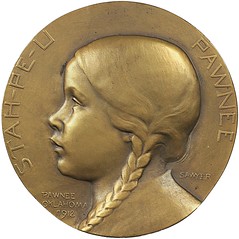
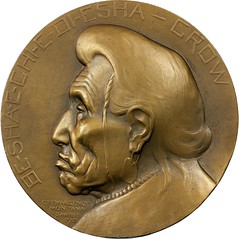
Eight of the 31 medals typical of North American Indians created by Edward W. Sawyer in the collection at the Massachusetts Historical Society
Sawyer made 35 Indian portraits between 1904 and 1913. It was reported that just 10 sets were struck, and no complete sets are known at this time. All of the medallions are currently believed to be in museum collections. The MHS obtained this group directly from Mr. Sawyer in 1921.
For more information about Medal Collectors of America, see:
www.medalcollectors.org
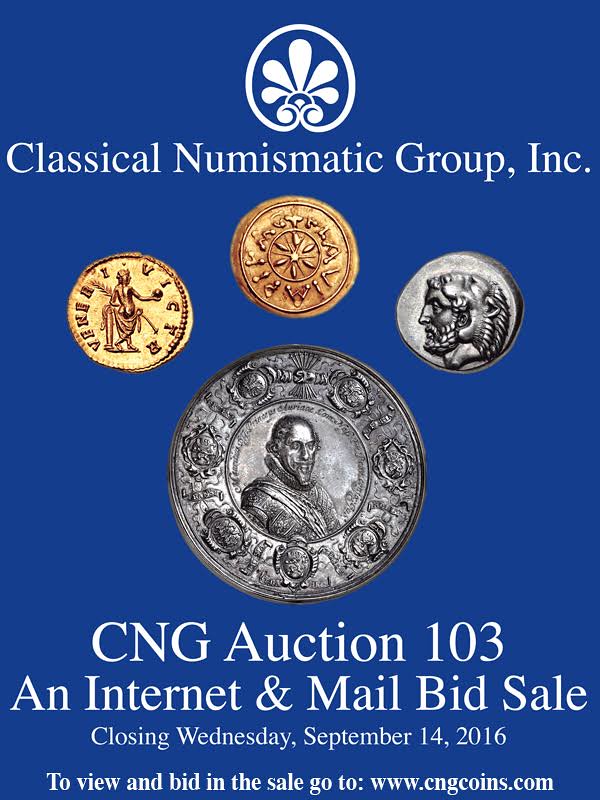
CLASSICAL NUMISMATIC GROUP SALE 103
An Internet and Mail Bid Sale
Closing Electronically on Wednesday, 14 September 2016,
from 10 AM ET
Classical Numismatic Group is proud to present CNG 103, an Internet and Mail Bid Sale closing electronically on Wednesday, 14 September 2016, from 10 AM ET (U.S.). This sale offers 1295 lots with a presale estimate of almost $2 million.
Our annual autumn sale features Greek, Celtic, Oriental Greek, Central Asian, Roman Provincial, Republican, and Imperial coinage. Additionally, there are featured selections of Byzantine, Early Medieval, Islamic, World, World Medals, British, British Medals, and Antiquities.
General selections of coins are included throughout the sale from the estate of Thomas Bentley Cederlind. Additionally, there are further selections from the M. A. Armstrong collection, and Greek and Roman coins from the Dr. Lawrence D. Sporty collection.
The Greek and Oriental Greek sections are highlighted by an extensive offering of Tarentine coinage, a unique gold oktadrachm of the Seleukid King Antiochos III, and Sasanian coins from the Grzesiak and Highland collections.
One of the featured collections in CNG 103 is the Korwin Collection of Roman Coinage, which covers the period of Julius Caesar to Zeno. In the Republican and Imperial sections, bidders will find offerings from the RBW collection, a run of Flavian “Judaea Capta” commemoratives, and an attractive Pertinax gold aureus, as well as a unique aureus of Constantine II, as Caesar, formerly part of the Biaggi collection.
The Byzantine section features coins from the Cederlind estate and Dr. Lawrence Sporty collection. The early Medieval section is highlighted by three important early Lombardic gold coins, while the World section includes further selections from the Dr. Lawrence A. Adams collection and the Cederlind estate.
CNG 103 features an impressive selection of Scottish coinage from the collection of Arthur M. Fitts III. Other items of note for this sale include an exquisite 19 th century collection of Napoleonic medals in a handcrafted contemporary case, and a spectacular Battle of Lowestoft gold medal of Charles II. This well-rounded sale concludes with a selection of antiquities from the Cederlind estate, and the Petite Museum of Hadji Baba. The final lot in CNG Auction 103 is the Pamphill Hoard of mid- late 3rd century Roman coinage. The Pamphill Hoard is an intact coin hoard found in October 2011 near Pamphill in Dorset, England, and includes the fragments of the two ceramic vessels that contained the coins when they were discovered.
Catalogs for CNG 103 have been mailed to our active mailing list and bidding is open on the site. Some of the individual highlights from CNG 103 are:
Lot 11: ETRURIA, Populonia. Circa 300-250 BC. AV 25 Asses
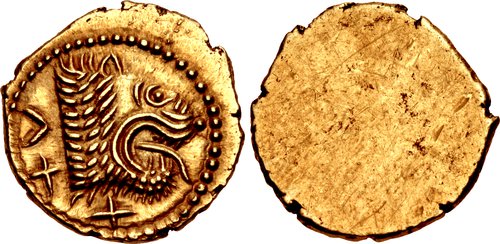
To read the complete lot description, see:
Illustrated in EC (www.cngcoins.com/Coin.aspx?CoinID=317678)
Lot 295: Kroisos Prototype Stater
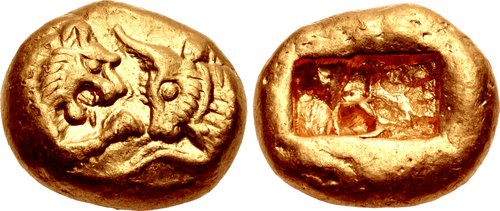
To read the complete lot description, see:
Kroisos Prototype Stater (www.cngcoins.com/Coin.aspx?CoinID=317962)
Lot 668: Lifetime Julius Caesar Denarius
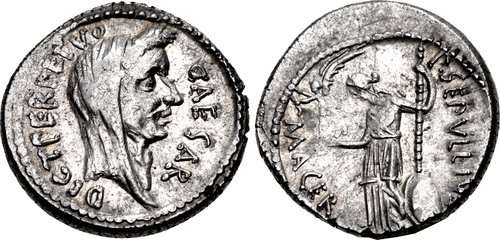
To read the complete lot description, see:
The Caesarians. Julius Caesar.
(www.cngcoins.com/Coin.aspx?CoinID=318335)
Lot 819: "Judaea Capta" Sestertius
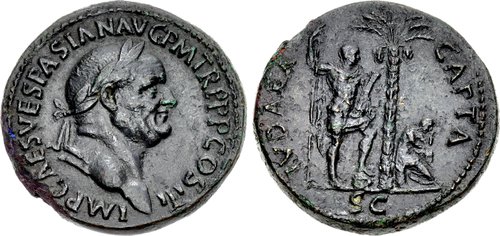
To read the complete lot description, see:
A Run of “Judaea Capta” Commemoratives
(https://www.cngcoins.com/Coin.aspx?CoinID=318486)
Lot 943: Constantine VI & Irene. 780-797. AV Solidus
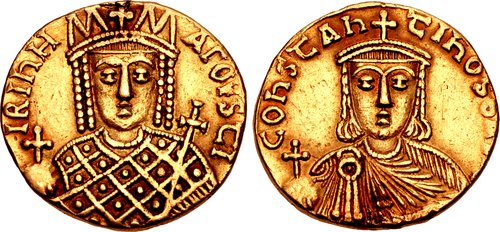
To read the complete lot description, see:
Ex Hunt Collection CNG 103, Lot: 943.
(www.cngcoins.com/Coin.aspx?CoinID=318610)
Lot 1115: Roman Imperial. Scipio Africanus
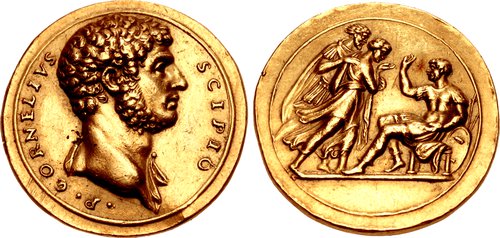
To read the complete lot description, see:
Two Gold Medals After Valerio Belli
(www.cngcoins.com/Coin.aspx?CoinID=318782)
Lot 1139: Maurits van Oranje Medal
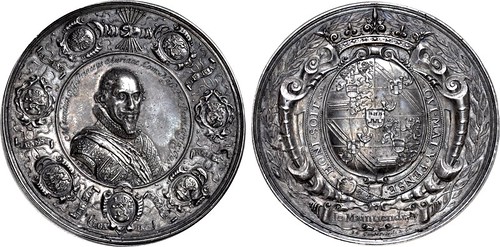
To read the complete lot description, see:
Exceptional Medal by Bijlaer (www.cngcoins.com/Coin.aspx?CoinID=318806)
Lot 1184: The Cursing Half Noble
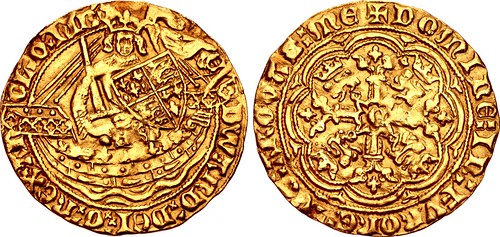
To read the complete lot description, see:
The Cursing Half Noble (www.cngcoins.com/Coin.aspx?CoinID=318851)
Lot 1227: Mary Abbey Crown
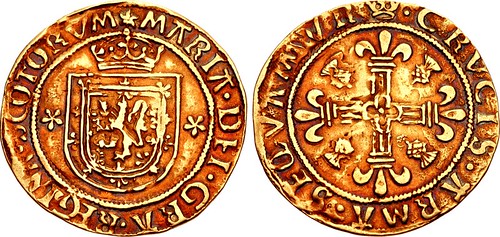
To read the complete lot description, see:
Mary Abbey Crown (www.cngcoins.com/Coin.aspx?CoinID=318894)
Lot 1248: The Battle of Lowestoft Medal
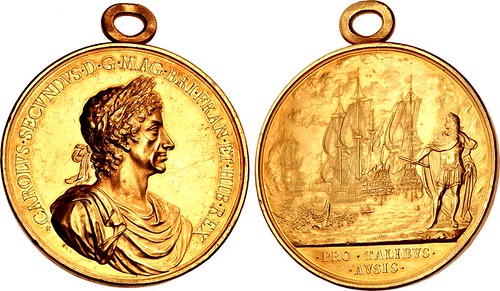
To read the complete lot description, see:
Battle of Lowestoft Medal (www.cngcoins.com/Coin.aspx?CoinID=318915)
Printed catalogs for CNG 103 are now available. To order the catalog, please call our U.S. office at (717) 390-9194. Catalogs have been mailed to customers on CNG’s active mailing list. Prospective bidders may also view the virtual catalogs at CNG 103 Virtual Catalog. The sale can be viewed online at cngcoins.com, sixbid.com and numisbids.com.
In addition to Internet & Mail Bid Sale 103, CNG will also feature over 850 lots from many of the same collections listed above in their Electronic Auction 383, closing two weeks later on Wednesday, September 28, 2016, from 10AM ET (U.S.). Bidding for CNG Electronic Auction 383 will begin on September 7, 2016.
CNG is currently accepting consignments for future auctions sales. Please contact the firm for further details and consignment deadlines.
For further details and any additional information, please contact CNG, Inc. at:
Classical Numismatic Group, Inc.
P.O. Box 479
Lancaster, PA 17608-0479
Telephone: (717) 390-9194
Fax: (717) 390-9978
Email: cng@cngcoins.com

AN INVESTIGATION OF ISIS COINAGE (ENGLISH SYNOPSES)
“Coins made by DAECH, a so-called Islamic State,” by Jérôme Jambu in Bulletin de la Société Française de Numismatique, December 2015.
Translated excerpts:
“In November 2014 DAECH announced its intention to mint and circulate its own money to replace that of “the tyrannical financial system imposed on Moslems,” that is to say, the world monetary system organized around the dollar. The proposed coinage would be in gold and silver, “as in the times of the first califs.” A coin of one dinar was announced by DAESCH in the middle of 2015 and it would carry a value of plus-or- minus $140.00. The announcement was broadcast widely beginning September 1, but its actual production probably started the following June. In the areas controlled by DAECH the news of this issuance was announced by paper fliers pasted on buildings. The coins followed a common design and were issued in seven denominations. There were no representations of living people, conforming to the laws of Charia. Obverse: inscriptions in Arab naskhi, cursive, read at the top ad-Dawlah al-Islamiyah (Islamic State) and at the bottom al-Khilafat ala Minhaj an-Nubuwwah (A Califat following the path of the Prophet). In the center the value was written in letters, their weight in grams, and the carats, for gold. These modern measures of weight and carat represent an incongruity because they are not of the time period the coin pretended to reestablish. Reverse: designs inanimate, the mark of value in figures, and in exergue the year 1436 of the Hégire."
"These coins were issued in a series: two coins in gold, three in silver, and two in copper."
"On August 28, 2015, a video showing the fabrication of the coins and their presence in the hands of combatants was distributed by the group on the internet. The announcement was relayed widely and magnified by international media, after September 1."
"In consideration of the complexities that abound concerning this possible issuance of coins we should perhaps consider the possibility that there were two strikings: one in precious metal for internal use and another in base metal for sale in foreign countries where their very existence and the legends on them would provide publicity for the terrorist organization."
"Another hypothesis, just as likely, is that the widely publicized initial striking never actually took place, except for a few pieces for propaganda."
Remember that all the information we have for the existence of these coins in precious metal comes from in the form of drawings, synthetic images, or photographs in which parts are blurred, without scaling, etc. And we have no neutral testimony to confirm their actual circulation.”
In conclusion the author notes that the dies, which are pictured in the article, were undoubtedly made by an experienced engraver, an arabisante because of the high quality of the workmanship and the carving of the legends which are similar in style to coins of the Arabian Peninsula. And concerning the metal required for fabrication the author notes that DAECH acquired a large quantity of gold ingots—approximately 200 kg—from the Banque Centrale Irakienne de Mossoul.
Chester adds:
I can't comment on the eBay coins because I haven't seen any. The author of the article does remark that there are probably Asian counterfeits, and some of the DAECH coins purported to be silver are iron with silver coating. I would suggest to anyone interested in these coins to contact one of the reputable European dealers connected to MA Shops, the on-line consortium.
To read the earlier E-Sylum article, see:
ARTICLES: AN INVESTIGATION OF ISIS COINAGE
(www.coinbooks.org/esylum_v19n35a07.html)
MORE ON THE BENJAMIN FRANKLIN COUNTERSTAMP
Last week I wrote about a 1799 Dollar “Counterstamped with the head of Benjamin Franklin” that was listed on a 1943 invoice from B. G. Johnson to F.C.C. Boyd that I had come across on the Newman Numismatic Portal. I’m happy to report that three people wrote me, all with related responses. It appears that a Civil War Token Die was used to strike this “portrait of Ben Franklin” onto the obverse of a 1799 Dollar. I wrote,
The last item on the invoice was a 1799 Silver Dollar, “Counterstamped with head of Benjamin Franklin.” It was called Very fine, and sold for $40.00. If anyone knows anything about this important counterstamped Dollar, please contact me at wdperki@attglobal.net . I have never seen or heard of this, despite a strong interest in counterstamped Early Dollars 1794-1803.
From John Okerson:
I found it in The Medals of Franklin by Phil W. Greenslet edited by David E. Schenkman of 1993 by Token and Medal Society, Inc. page 212 as item GT-705. The description says “(same as GT-701; struck on U.S. 1799 silver dollar) (blank except for coin design) silver 39 mm, R-10 (Fuld Civil War token 153/B1)”.
I looked at Fuld’s Photographic Plates for Patriotic Civil War Tokens, Volume 1 and found what appears to be the counterstamp token on Plate VI as number 153. This is a recent addition to NNP, so you should be able to download it there quite easily.
This is a civil war token die.
See Civil War Token Society Journal vol. 6, no. 2, page 46 (available on Newman Portal).
From David Gladfelter:
This coin (or token) is listed in the current (fifth) edition of the Fuld patriotic Civil War token catalog as die combination 153/0, overstruck on a silver planchet (code fo), rarity R10 (unique), with comment "over 1799 U.S. dollar". In the current (second) edition of the "Official Red Book Guide Book of Civil War Tokens," page 130, Q. David Bowers notes that die 153, which is only 18mm in diameter, has been used to make "numismatic strikes", still exists, and "has been used to make modern strikings."
Most notably, ANA president J. Henri Ripstra used it to strike a personal token in aluminum or white metal that was distributed at the 1939 ANA convention in New York City. Because of the small size of this die, it would be more correct to call the 153/0 a counterstamp than an overstrike.
I thank everyone for their interest and assistance! Thanks.
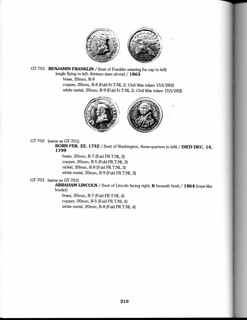
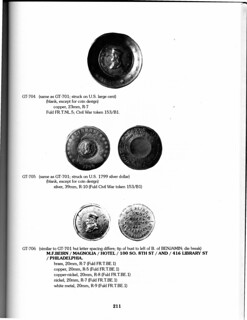
The Medals of Franklin
Len Augsburger adds:
The Newman Portal has grown past my ability to keep all its resources in my head and it is great to see the community mining its content.
To read the earlier E-Sylum article, see:
EARLY DOLLAR RESEARCH ON THE NEWMAN PORTAL
(www.coinbooks.org/esylum_v19n35a10.html)
THE BOOK BAZARRE
A NUMISMATIC CONNECTION TO MOE BERG
The article on Moe Berg, baseball player and spy, in last week's E-Sylum reminds me of his association will Bill Klein, a New York City numismatist. Bill was an accountant with the NYC office of the IRS – yes, there are good guys who work for the IRS.
Moe Berg met Bill in the IRS office when he had solved one of Moe’s income tax problems. The two hit it off. They became friends, really close since they both shared an intense common interest – books. Together the two shopped all the New York City’s bookstores, attended book auctions and occasionally hit bookstores travelling to New Jersey environs where Moe lived with his sister.
Bill built a library, more accurately described as a vast accumulation of books. His interests were extensive and his book buying reflected this. Moe’s book purchases were somewhat more centered but frequently they tried to outdo each other in their literary acquisitions. However, they shared the burning pleasure of owning a book.
The two were opposites in their personalities, perhaps it’s true what they say that opposites attract. Bill was sociable, Moe somewhat more reserved. Bill was married, Moe was a bachelor. Bill had no religion, Moe was Jewish, Bill was more sedate, Moe was athletic. The attraction was strongly intellectual, however, as both were well versed in knowledge of many subjects.
Bill collected coins and later found an interest in medallic art. It was this interest in medals that brought us together. He attended NYC coin shows were I sold him medals. He even purchased a silver Catskill Aqueduct Medal, not an insignificant purchase.
After his death his widow contacted me. Bill had instructed her to do so, apparently he liked my fairness in such transactions. She wanted me to sell Bill’s library. I said I was a medal dealer, not a book dealer, but she insisted. After three calls I relented to come inspect the library.
What I found was astonishing. It filled every room of an apartment in a building on New York City’s West Side. The quantity of books forced them to acquire a second nearby apartment to live in. At that time I was doing flea markets on weekends. Fortunately one was in a building with permanent booths, you could leave it set up every week. It also had a huge basement for storage.
In all I carted 1,600 boxes out of that apartment. I estimate there were more than 12,000 books Bill had amassed. Only a few were numismatic. These sold quickly to my friends. I kept several for myself, an autographed copy of Joseph F. Loubat on U.S. Mint medals and a biography of Hetty Green, called “Witch of Wall Street” for her savvy investing, mother of famed collector of the 1930s, Colonel Edward Green. The son inherited his mother’s estate of $100 million. It is said he poured most of that into coins and paper money.
The book is not even mentioned in her Wikipedia article. Somehow Bill found a copy and recognized its connection to numismatics.
I also kept two Moe Berg items. One was a signed Christmas card to Bill from Berg, another an inscribed book to Bill. While not a numismatist, Moe Berg was exposed to it from long-time friend, Bill Klein.
To read the earlier E-Sylum article, see:
MOE BERG'S PRESIDENTIAL MEDAL OF FREEDOM
(www.coinbooks.org/esylum_v19n35a33.html)

AZERBAIJAN HOARD OF MEDIEVAL ISLAMIC COINS
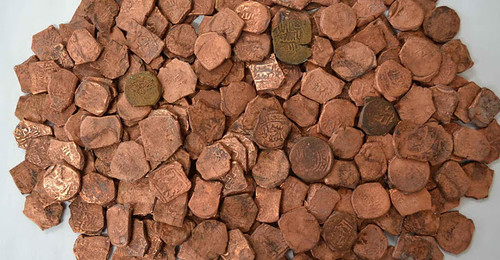
273 copper coins dating to the 12th century have been discovered during excavations near Uzuntepe village of the Jalilabad region, the Institute of Archaeology and Ethnography at the Azerbaijan National Academy of Sciences reported.
The coins were studied by Dr. Ali Rajabli and subsequently cleaned by Dr. Rauf Guliyev.
The coins date back to the rule of Eldiguzids dynasty (12th century), also known as Atabegs of Azerbaijan.
The inscriptions show that the coins were minted on behalf of the Seljuk Sultan Arslan Shah (1161-1176).
The name of the Abbasid Caliph was depicted on one side of the dirham, while the 33rd verse of Surah At-Taubah from the Holy Quran on the other side.
To read the complete article, see:
Hoard of medieval bronze coins discovered
in Azerbaijan (https://archaeologynewsnetwork.blogspot.com/2016/08/hoard-of-medieval-bronze-coins.html)
SELECTIONS FROM TIMOTHY MILLETT LIMITED
The Amicable Society, Instituted 1696
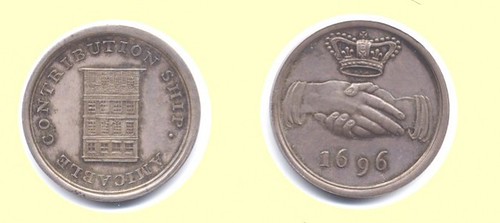
The Amicable Society, Instituted 1696, silver ticket, two hands clasped under the Royal Crown, rev. a building, AMICABLE CONTRIBUTIONSHIP, 39 mm (MI 155/422; DW 102/7). Extremely fine and very rare, especially in silver. £Sold
These medals and certain varieties were issued to commemorate the establishment of the first company for the insurance of houses against loss by fire. It later became known as The Hand in Hand.
To read the complete item description, see:
The Amicable Society, Instituted 1696
(www.historicmedals.com/viewItem.php?no=337)
The Catch Club, Instituted 1762
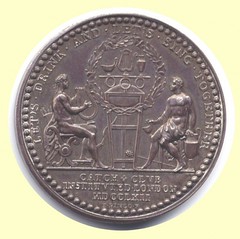
The Catch Club, Instituted 1762, silver pass, by T. Pingo, two figures seated beside a tripod, one playing a lyre, the other holding a cup, LETS. DRINK. AND LETS. SING TOGETHER, rev. a wreath of leaves, A Proof, 44mm (DW 152/397). Good extremely fine and rare, toned. £Sold
The Club met at the Thatched House in St. James's Street. Eimer states that the Club offered a ten-guinea premium to the composers of the best catch, canon and glee, set to words either in English, Latin, Italian, Spanish or French. At the time of initial production a silver example was given to the Duke of Devonshire.
To read the complete item description, see:
The Catch Club, Instituted 1762
(www.historicmedals.com/viewItem.php?no=236)

The Erection of Wilton Church
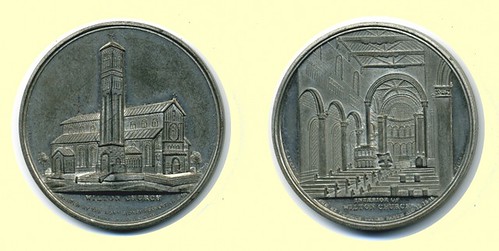
The Erection of Wilton Church, by E. Avern, /I. 51 mm (BHM 2254), Extremely fine and rare. £Sold
Wilton's Church of St. Mary and St. Nicholas, also known as the Italianate Church was designed by Thomas Henry Wyatt and David Brandon and erected between 1841 and 1845. Built at the behest of Catherine Woronzow, the Dowager Countess of Pembroke (see no. 120) and her son, Sidney Herbert, who donated £20,000 towards the building, it was described as one of the most sumptuous Anglican churches of the 1840's and the prime example in England of the round arch style. Catherine Woroznow was born in Russia and the influence of the Russian Orthodox style is strongly evident in the nave.Mosaics.
To read the complete item description, see:
The Erection of Wilton Church
(www.historicmedals.com/viewItem.php?no=750)
The Siege of Basing House
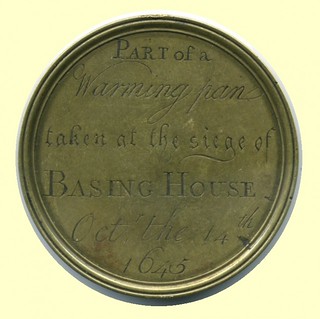
The Siege of Basing House, engraved brass medal, 1645, Part of a/ Warming Pan/ Taken at the Siege of/ Basing House/ Octr. the 14th/ 1645, rev. By/ Stephen Coombe/ who died/ Augt. the XXIV/ 1680 AETAT. 69; edge engraved Hector Prince of Troy 1633, 51 mm. Good very fine. £Sold
John Paulet, "the Great Loyalist" and Marquis of Winchester was one of Charles I's wealthiest supporters. His mansion, Basing House was surrounded by Cromwell's army on 8th October 1645. The bombardment began on 12th October and within a day the army had succeeded in breaking through the fortress walls, allowing an assault on 14th October. The house fell in less than an hour of fighting and along with the Marquis, the architect Inigo Jones was also captured.
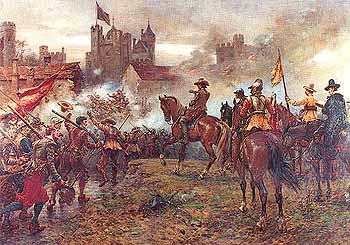
To read the complete item description, see:
The Siege of Basing House (www.historicmedals.com/viewItem.php?no=444)
For more information on the Siege of Basing House, see:
The Fall of Basing House, 1645
(http://bcw-project.org/military/english-civil-war/southern-england/basing-house-1645)
B A S I N G B E S I E G E D
(www.britannia.com/history/hants/siegebsg.html)
Coronation of William and Mary
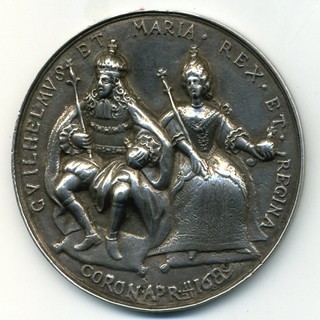
Coronation of William and Mary, silver medal, 1689, William and Mary seated facing, crowned and robed, each holding a sceptre and orb, rev. Captain, Lieutenant and Ensign of the City Guard of Amsterdam, City arms above, , 61 mm (MI 678/54; van Loon 390); formed as two plates joined by a rim and makers mark on the edge. Good very fine and rare. £Sold
To read the complete item description, see:
Coronation of William and Mary
(www.historicmedals.com/viewItem.php?no=973)
THE BOOK BAZARRE
RUSSIAN COPPER COINAGE AND THE SOHO MINT
Darryl Atchison writes:
Regrding the article on Steve Bishop's Russian coppers, if we ignore the first coin which I know nothing about, I have to say that the remainder of the pieces were instantly reminiscent of the Aglesey pieces (and other similar British tokens from that period) listed in Dalton & Hamer. The fabric appears to be consistent with products of Boulton's Soho Mint. I'd even have to wonder if the date on the 2nd coin isn't a punching error and should read 1788 as well.
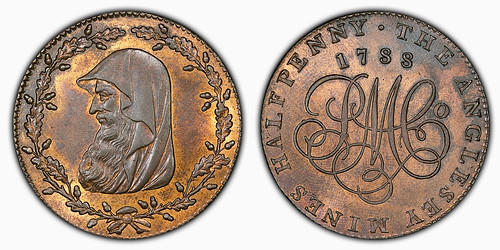
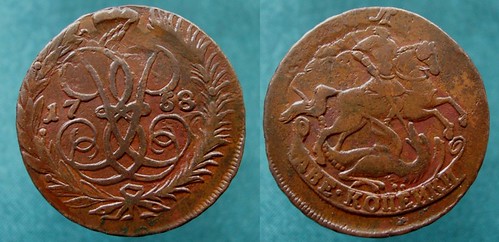
Darryl adds:
I can't find my copy of Doty's text on the Soho Mint but when I do get around to digging it out, I'll review it to see if Dick ever mentioned Boulton making coins for Russia at that time (or possibly exporting minting machinery, tools, dies, etc. to there).
In time, the Russian Government would indeed begin coining copper coinage at Matthew Boulton's mint, on Matthew Boulton's model. Copper patterns were prepared in 1810, and the first coinage for circulation entered the commerce of the capital later that year.
To read the earlier E-Sylum article, see:
NOTES FROM E-SYLUM READERS: AUGUST 28, 2016 : Steve Bishop's Russian
Coppers (www.coinbooks.org/esylum_v19n35a14.html)
THE BOOK BAZARRE
MORE ON BARMAID'S GRIEF
Granvyl Hulse writes:
Having lived in England for a fair number of years and spent a fair number of pleasant hours in the local pubs I can testify to the truth of the "barmaids grief." Most pubs were not brilliantly lighted during my time and having handled both the four and five shilling pieces myself I can understand why a barmaid who could only work by feel and not by sight would give back more change than she should have. This similarity in size, and its resulting confusion, is one reason why the four shilling piece did not have a long minting life.
Although Yossi Dotan quotes Richard Giedroyc's scepticism about the double florin (4 shillings, 1887 to 1890) as the "Barmaid's Grief", several things need to be borne in mind:
(a) For at least two centuries before 1887 there had not been a coin between the half-crown and crown (other than the clearly-marked 3-shilling Bank Tokens of 1811 to 1812).
(b) In 1887 we had new designs for all of our silver coins.
(c) With no internet, television or radio broadcasts, and large numbers of people being unable to read newspapers (whether illiterate or needing to "work all the hours God gave"), there would have been many people unaware of the new coin until too late.
(d) Crowns seem not to have been much in circulation as of shortly before 1887. Here are the mintage figures – dates (thousands) for the period 1823 to 1889: 1889 (1800), 1888 (132), 1887 (274), 1853 (0), 1847 (141+8), 1845 (158), 1844 (94), 1839 (0).
(e) In those days, pubs (like many other places) were very poorly/dimly lit.
(f) The then most recent crowns (1847 & 1853) had a "gothic" heraldic design, which was echoed in a simplified manner by the new double florin.
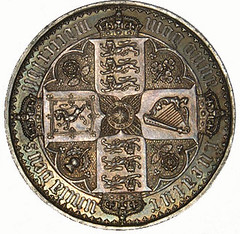
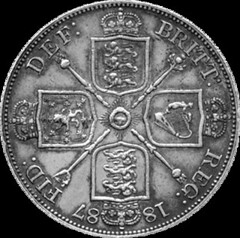
(g) The fact that Pistrucci's George-and-dragon reverse returned to the crown after an absence of over 65 years would surely have added to the confusion, because it thus bore no resemblance to the crowns already in circulation!
Meanwhile, the crowns of 1839 to 1845 – and most of those for 1847 – would have looked like this:
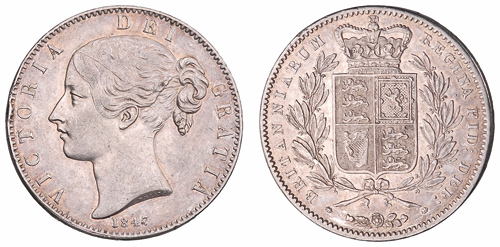
I must admit that I hadn't heard of the double florin as the "Barmaid's Grief" - I am much more aware of the "Barmaid's Horror", "Barmaid's Curse" or "Barmaid's Ruin". But these nicknames are because any shortfall would have been taken out of the wages. However, I am not aware of any (almost) contemporary information on the confusion.
The gold coins also changed design in 1887. However, this new sixpence was rapidly withdrawn because when gilded it could be passed as a half-sovereign if one did not look closely enough to distinguish the Garter motto from the inscription.
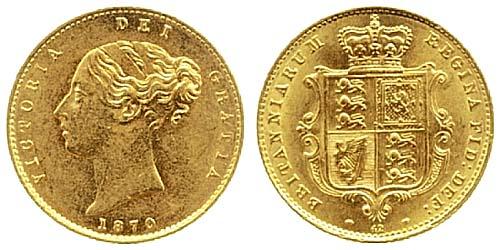
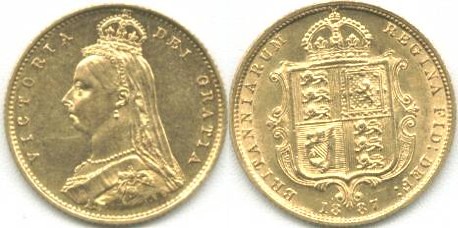
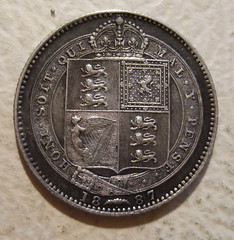
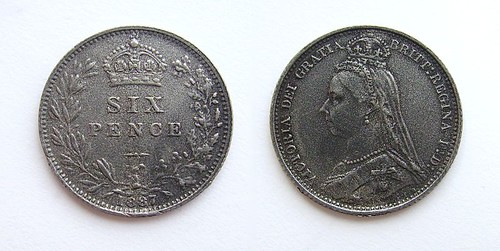
I am surprised at Yossi's story about the George IV sixpence, because no gold coins were ever issued with anything like the lion-and-crown design which he shows. And he is not quite right in stating that 1826-1829 "were the last years in which the sixpence was struck without denomination. Later issues clearly state the denomination" - the above-mentioned "withdrawn" 1887 sixpence is an exception, albeit the only one!
Maybe the gold plating on his sixpence was in connection with use in jewellery? Or maybe somebody was thinking of the the similarity of the earlier types of George IV sixpences to his half-sovereign?
By the way, to give some idea of prices, in 1887 best beer would probably have been 5 pence a quart – a crown would have bought some 24 pints, while in 1912 it would only have bought about 20 pints (at threepence a pint).
To read the earlier E-Sylum article, see:
QUERY: SIMILAR COIN PAIRS - BARMAID'S GRIEF
(www.coinbooks.org/esylum_v19n35a29.html)

JOHN NASH’S NOBEL MEDAL TO BE AUCTIONED
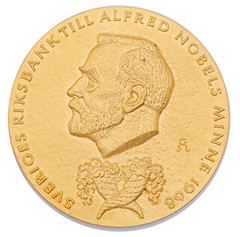
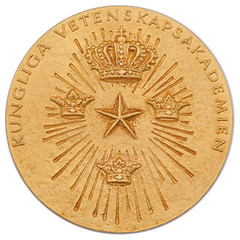
James D. Watson’s fetched $4.76 million in 2014, setting a record. William Faulkner’s failed to sell in 2013, after bidding stalled out at $425,000, short of the minimum.
Now, the Nobel Prize medal belonging to the mathematician John F. Nash, awarded in recognition of his fundamental contributions to game theory, is set to be auctioned at Sotheby’s in New York on Oct. 17. It carries an estimate of $2.5 to $4 million, which if reached will cement the apparent dominance — for now? — of scientists over literary types in the rarefied market for some of the world’s most difficult-to-acquire gold jewelry.
Mr. Nash, whose life inspired the movie “A Beautiful Mind,” won the Nobel Prize for economics in 1994, at a time when he was unemployed, after years of struggling with mental illness. The prize, he later said, “had a tremendous impact on my life, more than on the life of most prize winners.” (He died in a car accident last year, at age 86.)
Mr. Nash’s medal, which is being offered in its original red leather case, is only one of about a dozen Nobel medals known to have been sold at auction in the past few years, according to Sotheby’s, as part of a boomlet sometimes attributed to $2.2 million price fetched in 2012 by the medal awarded to Francis Crick, who is among the discoverers with Mr. Watson of the double-helix structure of DNA. Scientists are not the only one to break $1 million: The 1936 Nobel Peace Prize medal awarded in 1936 to Carlos Saavedra Lamas, a former foreign minister of Argentina, sold for $1.1 million in 2014.
To read the complete article, see:
Beautiful Mind, Valuable Medal:
John Nash’s Nobel to Be Auctioned (www.nytimes.com/2016/08/31/arts/john-nash-nobel-medal-to-be-auctioned-at-sothebys.html)
John F. Nash Jr. was a more than worthy recipient of this prestigious award. A mathematical genius with graduate degrees from Carnegie Tech and Princeton University, the brilliant Nash received the Sveriges Riksbank Prize in Economic Sciences in Memory of Alfred Nobel in 1994 by the Royal Swedish Academy of Sciences.
With its gold medal in its original red morocco case, accompanying calligraphic diploma with an original watercolor drawing by Bengt Landin, the original box and attaché case for the diploma, and official letters from the Nobel Foundation and the Royal Swedish Academy of Sciences, John F. Nash, Jr.'s 1994 Nobel Memorial Prize in Economic Sciences is one of the most complete documentations of the Nobel Prize to ever be offered for auction.
To read the complete article, see:
A Mathematical Genius’s Nobel Prize Comes to Auction
(www.sothebys.com/content/sothebys/en/news-video/blogs/all-blogs/Bibliofile/2016/08/john-f-nash-jr-nobel-prize-economic-studies.html)

RARE GOLD LIFEBOAT DISASTER MEDAL MISSING
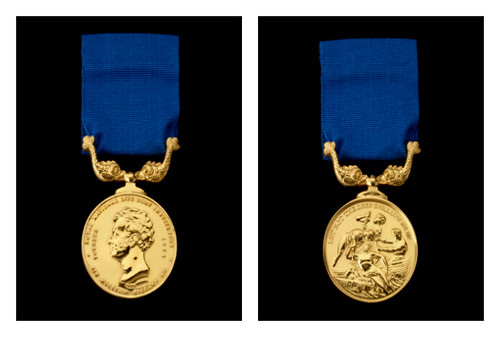
A gold gallantry medal awarded posthumously to one of the heroes of the Penlee lifeboat disaster has gone missing from the RNLI's HQ - and the charity suspects it has been stolen,
The medal was given to William Trevelyan Richards, coxswain of the Solomon Browne, the Penlee lifeboat from Mousehole in Cornwall, which went to the aid of the coaster Union Star after its engines failed in heavy seas in December 1981.
Both vessels were lost with all hands: 16 people died including eight volunteer lifeboatmen.
The gold medal, the RNLI's highest award for bravery, was awarded posthumously to William Trevelyan Richards, coxswain of the Solomon Browne.
The medal is one of the most precious artefacts in the RNLI's heritage collection.
In its 192-year history, the RNLI has awarded 151 gold medals to its lifeboat crews. Only one – William Trevelyan Richards – was awarded posthumously. The medal has been compared to the Victoria Cross in its significance and recognition.
The RNLI said the medal was recently found to be missing from a dedicated secure facility at the charity's head office in Poole, Dorset.
In spite of an extensive search the medal has not been found and police have been notified of a suspected theft.
To read the complete article, see:
Penlee Lifeboat
Disaster medal 'stolen' from RNLI HQ Read more at
http://www.plymouthherald.co.uk/rnli-loses-penlee-disaster-gallantry-medal/story-29670936-detail/story.html#mPmukO6UzAyLlrkd.99
(www.plymouthherald.co.uk/rnli-loses-penlee-disaster-gallantry-medal/story-29670936-detail/story.html)
BOND PRICES AND EARLY AMERICAN FINANCE
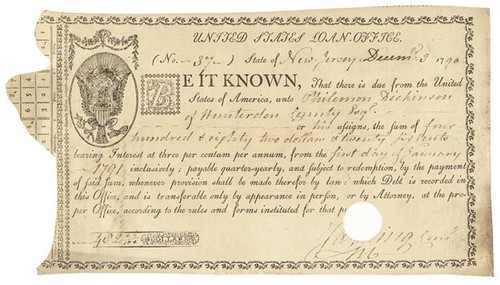
U.S. Loan Office bond issued in 1790, paying 3 percent interest.
America’s early finances were, in a word, messy. The states took on enormous debt to fund the Revolutionary War while the national government chartered by the Articles of Confederation issued bonds, took out foreign loans, and even benefitted from personal gifts, all while it had no power to collect taxes. “It was the price of liberty,” Hamilton wrote in his First Report on the Public Credit in 1790. That same report addressed the nation’s credit—during the 1780s, state debt traded at a significant discount to par, as low as $10, or ten percent their original value (a bond’s face value is $100), implying that investors generally didn’t expect to be paid back. Add to that the significant inflation that the nation suffered, and government bonds were certainly not a good investment.
Hamilton and the new Congress realized that strong credit was essential for the government to be able to borrow on good terms in times of war and for investment projects in their capital-scarce country. With the advent of the 1787 Constitution and Hamilton’s plan for the federal government to take on states’ unpaid obligations, it seemed governments at both levels would be on surer footing. As the new government began operations, how did these financial reforms play out? Today, U.S. government bonds are the safest available, the “risk-free” asset that influences interest rates around the world. But the 1780s and 1790s were a crucial period for U.S. debt, which, as the data bears out, established the nation’s credit and future success.
In Hamilton’s words, a given speculator “paid what the commodity was worth in the market, and took the risks of reimbursement upon himself.” Bond prices ought to reflect investor sentiment towards the debt obligations of the federal government, including how likely it was the U.S. was to pay off debt as it came due. Data compiled by Sylla, Wilson, and Wright include prices recorded for a variety of securities in U.S. financial markets from 1790 to 1860, including U.S. bonds. Examining the movements in the prices of these bonds, we can see how the nation built its early credit.
To read the complete article, see:
WHAT DO BOND PRICES TELL US ABOUT THE EARLY
REPUBLIC? (https://allthingsliberty.com/2016/08/bond-prices-tell-us-early-republic/)

Archives International Auctions, Sale 35
Chinese, Asian & Worldwide Banknotes,
Chinese Scripophily, Coins and
Security Printing Ephemera
September 26, 2016
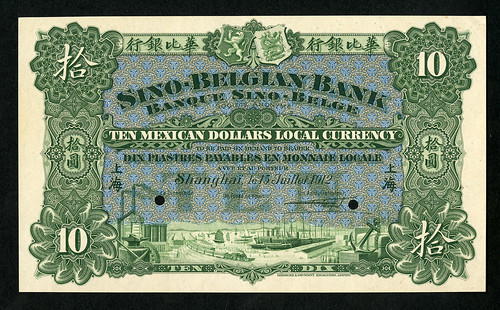
Click the links! Highlights include:
Lot 49: Lot 49 British North Borneo Company
Lot 74: Ming Dynasty Circulating Note
Lot 172: Lot 172 Russo-Asiatic Bank, 1913-1917
Lot 174: Sino-Belgian Bank, 1908-1912 Mexican Dollar
Lot 272: Banco Nacional 1899 Provisional Issues
Lot 307: National Bank of the Danish West Indies 1905 Specimen
Lot 356: Ethiopia 500 Thalers 1932 High Grade rarity
View the Virtual Catalog
Download the Catalog in PDF format
ARCHIVES INTERNATIONAL AUCTIONS, LLC
1580 Lemoine Avenue, Suite #7
Fort Lee, NJ 07024
Phone: 201-944-4800
Email: info@archivesinternational.com
WWW.ARCHIVESINTERNATIONAL.COM
SHELL OIL'S PRESIDENT'S GAMEPIECE PACKAGING
The article on Shell Oil's President's Game brought back a lot of memories. My family always bought gasoline at Shell stations, and we acquired many of those pieces during the program's run. We never won anything, as the winning medals were carefully rationed. As I recall, the key to the grand prize was Warren G. Harding. I never heard of anyone finding that particular medal.
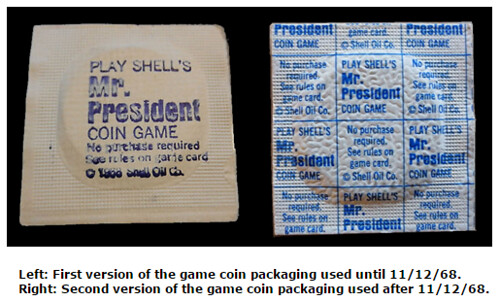
Each piece was sealed in a white, plastic envelope, and the older boys called them rubbers. Being only ten at the time, I didn't know what galoshes had to do with it. A couple teenagers in the neighborhood showed up with a bonanza of several hundred sealed medals one day, claiming that they'd found them in the sewer. Even I was smart enough to surmise that they were probably stolen from a station, which would have been in keeping with their general demeanor, but it was still quite an exciting event nonetheless. Not a single Harding turned up in that hoard, though there were enough pieces for some lower value prizes.
Customers could win a complete set of the medals in brass as one of the prizes, but I don't know anyone who did. A fellow coin collector among my circle of fifth-grade numismatists received a brass set that his parents had purchased from Shell through the mail, but I don't remember the selling price.
To read the earlier E-Sylum article, see:
SHELL'S MR. PRESIDENT COIN GAME TOKENS
(www.coinbooks.org/esylum_v19n35a31.html)
AUSTRALIA LAUNCHES TACTILE BANKNOTE
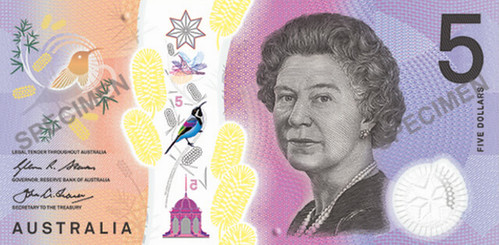
Australia's newest banknote goes into circulation on 1 September with a tiny new feature designed to help people who are blind or visually impaired.
The A$5 note has two raised dots on both of its long sides, allowing those who cannot see to identify its value, ABC reports. It's the country's first note to feature the tactile markings, and is being hailed as a major breakthrough. "For the first time in the history of Australian currency it will be possible for someone who is blind or vision-impaired to just pick up a note and know instantly what it is," says Bruce Maguire from the non-profit Vision Australia organisation. He says the change will help 360,000 Australians.
Currently, blind or visually impaired people have to rely on others to identify the note and give the correct change. Some use a measuring instrument - which ABC News notes can be fiddly in a busy shop - or smart phone apps.
The new design follows a petition started in 2012 by teenager Connor McLeod, who is blind from birth, and his mother. It gathered more than 57,000 signatures and is being credited with persuading the Reserve Bank of Australia to make the change. "Now when I grow up, I won't have to rely on trusting that people have always given me the right change," Connor writes on the news.com.au website. "I can feel the markings on the bank notes and tell them if they've given me the wrong change and also think to myself: I did that."
To read the complete article, see:
Australia launches tactile banknote to aid blind people
(www.bbc.com/news/blogs-news-from-elsewhere-37231007)
To read the earlier E-Sylum articles, see:
CAMPAIGN FOR TACTILE AUSTRALIAN BANKNOTES
(www.coinbooks.org/esylum_v17n22a23.html)
AUSTRALIA AGREES TO PRODUCE TACTILE BANKNOTES
(www.coinbooks.org/esylum_v18n08a26.html)
Today, the launch of the new $5 banknote, which has a tactile feature, is a significant outcome for the Australian blindness and low vision community, to which, I belong.
Let me explain. One of the fondest memories from my childhood is playing Monopoly. Sometimes my parents, sisters and I would play the short game which took about an hour and a half. Sometimes, we’d play the long game, which would often stretch into the night.
But as good as my game plans were there was always an extra obstacle I faced, that my competitors did not.
For a blind kid, like me, handling Monopoly money was tricky. Every banknote was the exact same length and width. So, I had to rely on other people — my Monopoly opponents — to help me sort it into piles. If there’s one thing I learnt, it was to never trust a Monopoly opponent with your money.
I once attempted to put braille labels on the Monopoly money. It helped, but there was so much of it that I quickly realised it would take a long time to label them all. Back in the real world, people often ask me why braille isn’t embossed on our banknotes. Although a number of countries have tried this approach, the braille dots squash after a while, and eventually, you can’t feel them at all.
In the last few years, developments in note-printing technology have made it possible to include a tactile feature as part of the structure of the banknotes themselves, rather than being embossed or added to the banknotes later. The tactile feature will last as long as the banknote itself and, importantly, won’t fade over time.
The introduction of the tactile feature is one of the most significant inclusive actions to take place in my life. Having to rely on other people or a device to identify banknotes just isn’t the kind of independence and participation in community life that leads to dignity, equality and inclusion.
To read the complete article, see:
Australia’s new $5 banknote is a breakthrough for the blind
(www.theaustralian.com.au/opinion/australias-new-5-banknote-a-breakthrough-for-the-blind/news-story/c0fd90029f1c29a0caeb27829e330705)
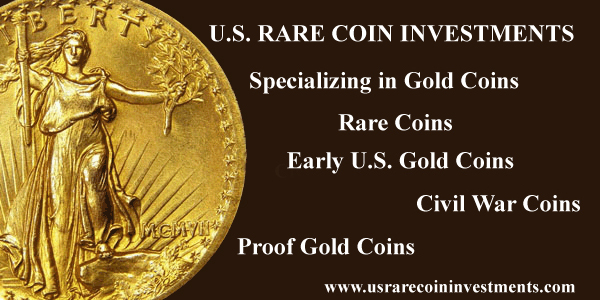
RIOS LAUNCHES TEACHERS RIGHTING HISTORY
When Phil Wilder stepped into his history classroom last year on the first day of school, he noticed something peculiar for the first time in the nearly 34 years he had been teaching at Moreau Catholic High School.
Among the posters of historical Americans on the wall were late presidents Abraham Lincoln and George Washington and others, but there were none of women.
The epiphany came after watching a television segment on a former student, then-U.S. Treasurer Rosa "Rosie" Rios, who had embarked on a mission to redesign the nation's currency, place abolitionist Harriet Tubman on the face of the $20 bill and pave the way for women to appear on the $5 and $10 bills.
After sending Rios an email, Wilder added posters of historical American women to the walls, including Tubman and suffragist Susan B. Anthony.
"It just really hit me that every day we can go through things, not see things and it may not register, but the fact that we don't have something can be just as important as something that we do have," Wilder said in an interview at Moreau.
What followed was a yearlong collaboration between Rios and Moreau to launch a nationwide initiative, called Teachers Righting History, that promotes the study of historical American women across all subjects.
The initiative officially began Aug. 26 at the school, coinciding with Women's Equality Day.
The goal is to have educators and students access a Treasury Department-compiled database created in the currency redesign process and other resources to "be creative and continue the discussion about our foremothers, as well as our forefathers, and really not just make this gender-centric but make it gender-neutral," Rios said.
To read the complete article, see:
Hayward: Former U.S.
treasurer kicks off historical women educational project at Moreau high school
(www.eastbaytimes.com/education/ci_30317071/hayward-former-u-s-treasurer-kicks-off-historical)
CHINESE CAPTIVE SAVED BY MESSAGES ON BANKNOTES
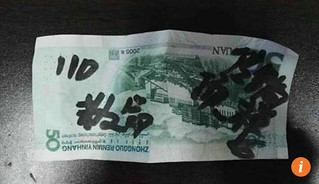 A man who was being held captive in a residential building in eastern China by a group that ran a pyramid scheme was freed after throwing
almost 800 yuan (HK$930) of banknotes with help messages on them, the Modern Express reports.
A man who was being held captive in a residential building in eastern China by a group that ran a pyramid scheme was freed after throwing
almost 800 yuan (HK$930) of banknotes with help messages on them, the Modern Express reports.
One of the 50 yuan notes was picked up by an elderly woman who was walking in the residential area in Changzhou, Jiangsu province. She read the handwritten messages of “help” and “110” – the emergency police number – but thought it was a prank.
She took it more seriously the next day after she found a piece of paper wrapped around a 100 yuan note with more messages and an identity card, and called the police. Police officers found the man in an apartment on the fifth floor, and the captive broke down in tears when they arrived.
The man, who was from Jiangxi province, said he had fallen in love with a woman online and she invited him to Changzhou to meet. On arrival, he was taken to the apartment and had his mobile phone taken away, and his captors watched him closely even when he used the toilet.
He said he had tried to escape without success, then thought of asking for help on banknotes. He had almost lost hope after tossing nearly 800 yuan from the apartment. The three pyramid group leaders have been detained by police.
To read the complete article, see:
Chinese man
rescued from captivity after writing SOS messages on banknotes
(www.scmp.com/news/china/society/article/2011162/chinese-man-rescued-captivity-after-writing-sos-messages)
FEATURED WEB PAGE: 125 YEARS OF COLLECTING
This week's Featured Web Page is 125 Years of Collecting with the American Numismatic Association, an article being published serially in The Numismatist by Dave Bowers in the quasquicentennial year of the ANA. Thanks to John and Nancy Wilson for this one.This year marks the 125th anniversary of the American Numismatic Association, of which you and I are proud members. Founded in Chicago in October 1891, the ANA has grown to include nearly 25,000 members and has become the world’s largest organization devoted to the history, lore and lure of coins, tokens, medals and paper money. Today, the ANA’s activities, educational programs and services are extensive and varied, including a museum and library, as well as conventions, seminars, online offerings and, of course, The Numismatist, which remains members’ primary benefit and source of Association news. With this issue, I begin a series of monthly features about the history of the ANA, summarizing its progress and, along the way, its problems, potential and pleasures. This month, I offer a prologue— the pursuit of the hobby in America in the early days leading up to the debut of The Numismatist in 1888 and the foundation of the Association three years later.
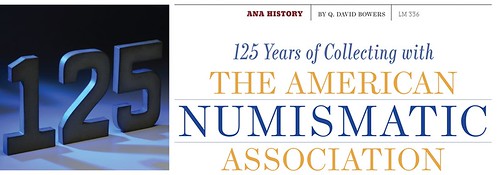
www.money.org/125yearsofcollecting

